作者:duktig
博客:https://duktig.cn (文章首发)
优秀还努力。愿你付出甘之如饴,所得归于欢喜。
MapReduce
Hadoop系列
MapReduce 概述
定义
MapReduce 是一个分布式运算程序的编程框架,是用户开发“基于 Hadoop 的数据分析应用”的核心框架。
MapReduce 核心功能是将用户编写的业务逻辑代码和自带默认组件整合成一个完整的分布式运算程序,并发运行在一个 Hadoop 集群上。
MapReduce优缺点
优点
1、易于编程。 用户只关心,业务逻辑。 实现框架的接口。
2、良好扩展性:可以动态增加服务器,解决计算资源不够问题
3、高容错性。任何一台机器挂掉,可以将任务转移到其他节点。
4、适合海量数据计算(TB/PB) 几千台服务器共同计算。
缺点
1、不擅长实时计算。 Mysql(在毫秒或者秒级内返回结果)
2、**不擅长流式计算。 Spark Streaming | flink 。**流式计算的输入数据是动态的,而 MapReduce 的输入数据集是静态的,不能动态变化。
3、不擅长DAG有向无环图计算。spark 。 多个应用程序存在依赖关系,后一个应用程序的输入为前一个的输出。在这种情况下,MapReduce 并不是不能做,而是使用后,每个 MapReduce 作业的输出结果都会写入到磁盘,会造成大量的磁盘 IO,导致性能非常的低下。
MapReduce 核心思想
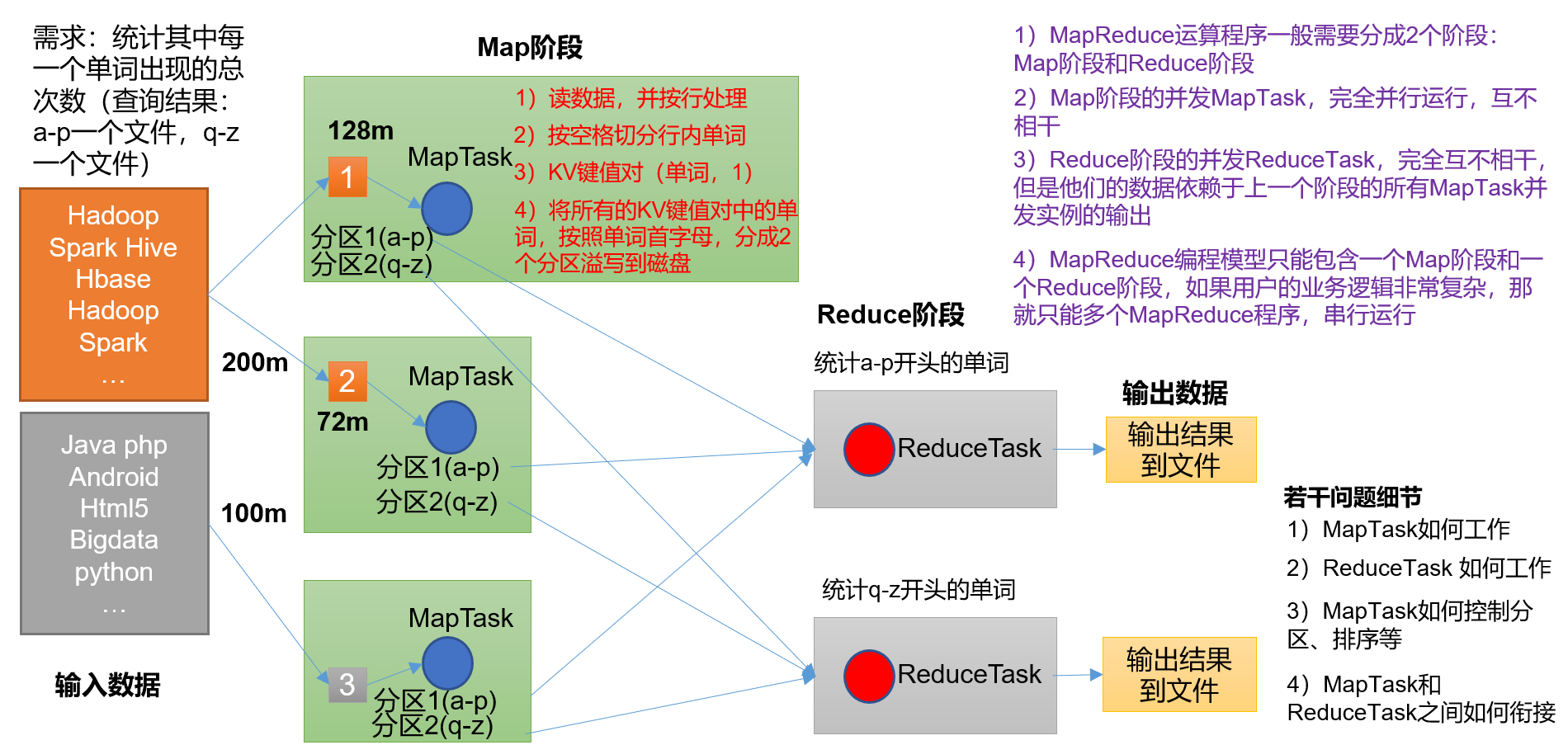
MapReduce 进程
一个完整的 MapReduce 程序在分布式运行时有三类实例进程:
(1)MrAppMaster:负责整个程序的过程调度及状态协调。
(2)MapTask:负责 Map 阶段的整个数据处理流程。
(3)ReduceTask:负责 Reduce 阶段的整个数据处理流程。
常用数据序列化类型
| Java 类型 | Hadoop Writable 类型 |
|---|---|
| Boolean | BooleanWritable |
| Byte | ByteWritable |
| Int | IntWritable |
| Float | FloatWritable |
| Long | LongWritable |
| Double | DoubleWritable |
| String | Text |
| Map | MapWritable |
| Array | ArrayWritable |
| Null | NullWritable |
MapReduce 编程规范
1.Mapper阶段
(1)用户自定义的Mapper要继承自己的父类
(2)Mapper的输入数据是KV对的形式(KV的类型可自定义)
(3)Mapper中的业务逻辑写在map()方法中
(4)Mapper的输出数据是KV对的形式(KV的类型可自定义)
(5)map()方法(MapTask进程)对每一个<K,V>调用一次
2.Reducer阶段
(1)用户自定义的Reducer要继承自己的父类
(2)Reducer的输入数据类型对应Mapper的输出数据类型,也是KV
(3)Reducer的业务逻辑写在reduce()方法中
(4)ReduceTask进程对每一组相同k的<k,v>组调用一次reduce()方法
3.Driver阶段
相当于YARN集群的客户端,用于提交我们整个程序到YARN集群,提交的是
封装了MapReduce程序相关运行参数的job对象
MapReduce实战——WordCount 统计单词次数
按照 MapReduce 编程规范,分别编写 Mapper,Reducer,Driver。
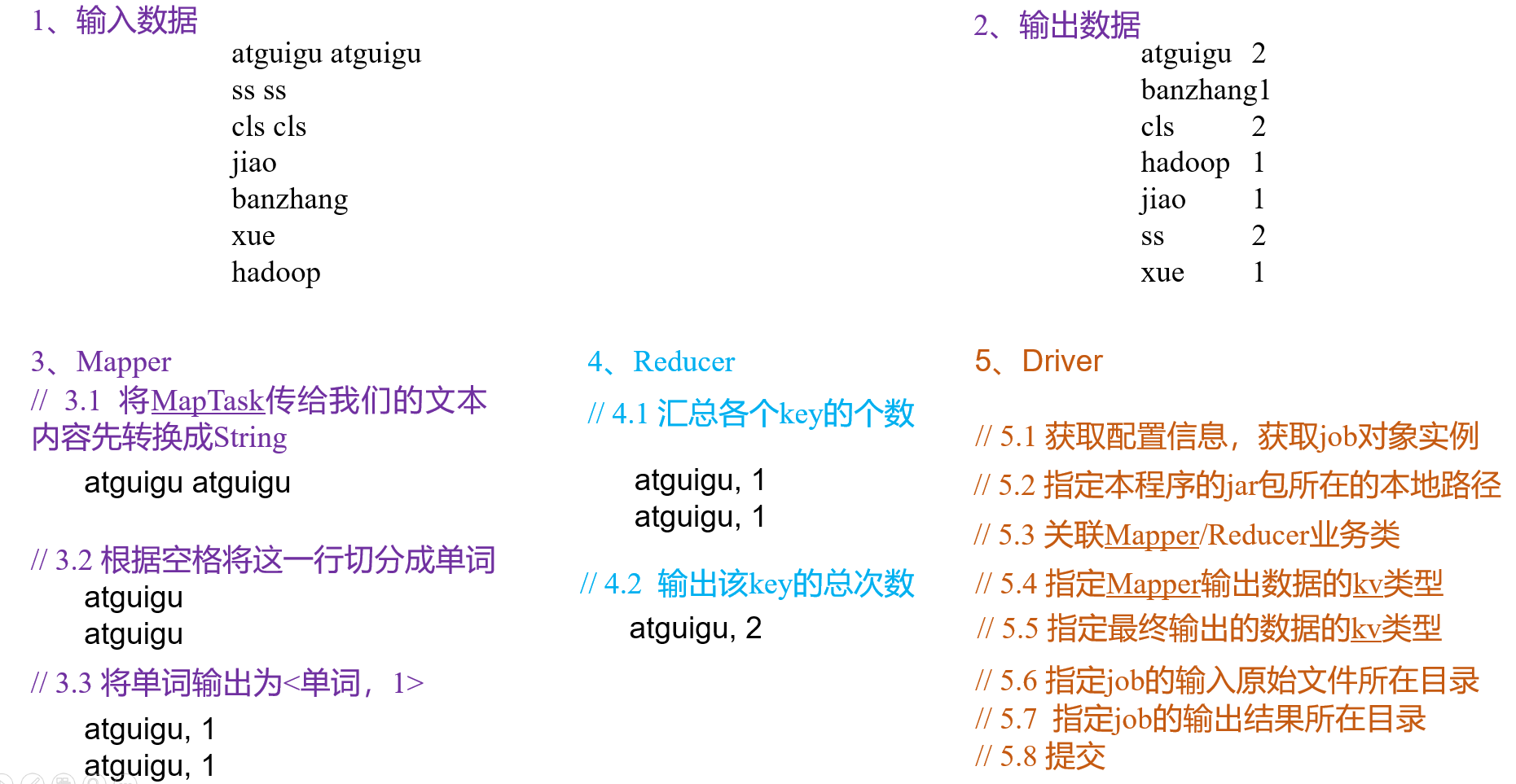
编写 Mapper 类
public class WordCountMapper extends Mapper<LongWritable, Text, Text, IntWritable> {
Text outK = new Text();
IntWritable outV = new IntWritable(1);
/**
* 一行数据执行一次
*/
@Override
protected void map(LongWritable key, Text value, Context context) throws IOException, InterruptedException {
// 1 获取一行: duktig duktig
String line = value.toString();
// 2 切割
// duktig
// duktig
String[] words = line.split(" ");
// 3 输出
for (String word : words) {
// outK 和 outV for循环执行多次,一行数据执行一次 map方法,避免频繁创建对象,故写成成员变量
outK.set(word);
context.write(outK, outV);
}
}
}
编写 Reducer 类
public class WordCountReducer extends Reducer<Text, IntWritable, Text, IntWritable> {
IntWritable outV = new IntWritable();
/**
* 一个key执行一次
*/
@Override
protected void reduce(Text key, Iterable<IntWritable> values, Context context) throws IOException,
InterruptedException {
// 1 累加求和 duktig,(1,1)
int sum = 0;
for (IntWritable count : values) {
sum += count.get();
}
// 2 输出
outV.set(sum);
context.write(key, outV);
}
}
编写 Driver 驱动类
public class WordCountDriver {
public static void main(String[] args) throws IOException, ClassNotFoundException, InterruptedException {
// 1 获取配置信息以及获取 job 对象
Configuration conf = new Configuration();
Job job = Job.getInstance(conf);
// 2 关联本 Driver 程序的 jar
job.setJarByClass(WordCountDriver.class);
// 3 关联 Mapper 和 Reducer 的 jar
job.setMapperClass(WordCountMapper.class);
job.setReducerClass(WordCountReducer.class);
// 4 设置 Mapper 输出的 kv 类型
job.setMapOutputKeyClass(Text.class);
job.setMapOutputValueClass(IntWritable.class);
// 5 设置最终输出 kv 类型
job.setOutputKeyClass(Text.class);
job.setOutputValueClass(IntWritable.class);
// 6 设置输入和输出路径
FileInputFormat.setInputPaths(job, new Path(args[0]));
FileOutputFormat.setOutputPath(job, new Path(args[1]));
// 7 提交 job
boolean result = job.waitForCompletion(true);
System.exit(result ? 0 : 1);
}
}
测试
在项目模块的resources下编写输入文件——WordCountInput.txt
duktig duktig
FPX
RNG EDG
LNG
FPX
在 Driver 驱动类 的第6步,没有直接读取文件路径,而是读main方法的参数,开发环境下可以利用idea写参数。(如果只是为了测试,路径写死即可)
第一个参数:输入文件路径
第二个参数:输出文件目录
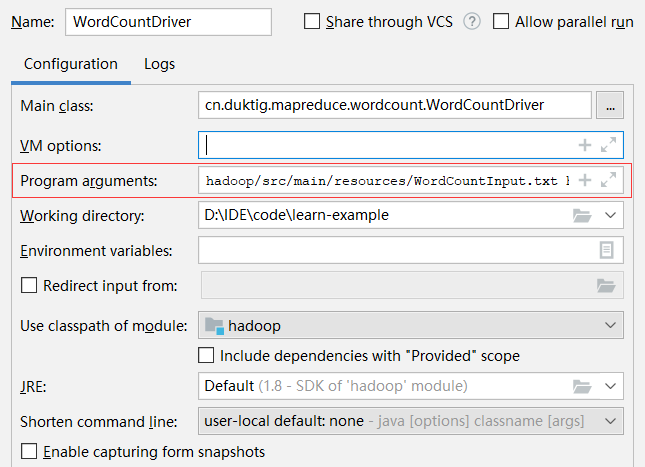
参数内容:
hadoop-example/src/main/resources/WordCountInput.txt hadoop-example/src/main/resources/WordCountOutput
注意:junit相对路径以src开始,main方法相对路径以module开始。
结果:
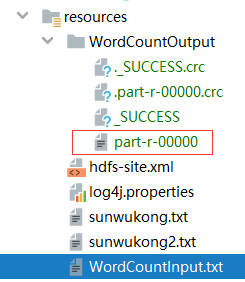
part-r-00000统计结果:
EDG 1
FPX 2
LNG 1
RNG 1
duktig 2
生产环境下,如果在linux,可将项目模块打成jar包,然后执行命令运行:
hadoop jar xxx.jar
cn.duktig.mapreduce.wordcount.WordCountDriver 输入文件路径 输出文件目录
MapReduce序列化
序列化概述
什么是序列化 ?
序列化就是把内存中的对象,转换成字节序列(或其他数据传输协议)以便于存储到磁盘(持久化)和网络传输。
反序列化就是将收到字节序列(或其他数据传输协议)或者是磁盘的持久化数据,转换成内存中的对象。
为什么要序列化 ?
一般来说,“活的”对象只生存在内存里,关机断电就没有了。而且“活的”对象只能由本地的进程使用,不能被发送到网络上的另外一台计算机。 然而序列化可以存储“活的”对象,可以将“活的”对象发送到远程计算机。
为什么不用 Java 的序列化 ?
Java 的序列化是一个重量级序列化框架(Serializable),一个对象被序列化后,会附带很多额外的信息(各种校验信息,Header,继承体系等),不便于在网络中高效传输。所以,Hadoop 自己开发了一套序列化机制(Writable)。
Hadoop 序列化特点:
(1)紧凑 :高效使用存储空间。
(2)快速:读写数据的额外开销小。
(3)互操作:支持多语言的交互
自定义 bean 对象实现序列化接口(Writable)
在企业开发中往往常用的基本序列化类型不能满足所有需求,比如在 Hadoop 框架内部传递一个 bean 对象,那么该对象就需要实现序列化接口。
具体实现 bean 对象序列化步骤如下 7 步:
-
必须实现
Writable接口 -
反序列化时,需要反射调用空参构造函数,所以必须有空参构造
public FlowBean() { super(); } -
重写序列化方法
@Override public void write(DataOutput out) throws IOException { out.writeLong(upFlow); out.writeLong(downFlow); out.writeLong(sumFlow); } -
重写反序列化方法
@Override public void readFields(DataInput in) throws IOException { upFlow = in.readLong(); downFlow = in.readLong(); sumFlow = in.readLong(); } -
注意反序列化的顺序和序列化的顺序完全一致
-
要想把结果显示在文件中,需要重写
toString(),可用"\t"分开,方便后续用。 -
如果需要将自定义的 bean 放在 key 中传输,则还需要实现
Comparable接口,因为MapReduce 框中的 Shuffle 过程要求对 key 必须能排序。@Override public int compareTo(FlowBean o) { // 倒序排列,从大到小 return this.sumFlow > o.getSumFlow() ? -1 : 1; }
序列化案例(统计手机号的流量)
需求:
统计每一个手机号耗费的总上行流量、总下行流量、总流量
输入数据:
phone_data .txt
id 手机号码 网络ip 上行流量 下行流量 网络状态码
1 13736230513 192.196.100.1 www.atguigu.com 2481 24681 200
2 13846544121 192.196.100.2 264 0 200
3 13956435636 192.196.100.3 132 1512 200
4 13966251146 192.168.100.1 240 0 404
5 18271575951 192.168.100.2 www.atguigu.com 1527 2106 200
……
输出数据:
期望输出数据格式
13560436666 1116 954 2070
手机号码 上行流量 下行流量 总流量
需求分析:
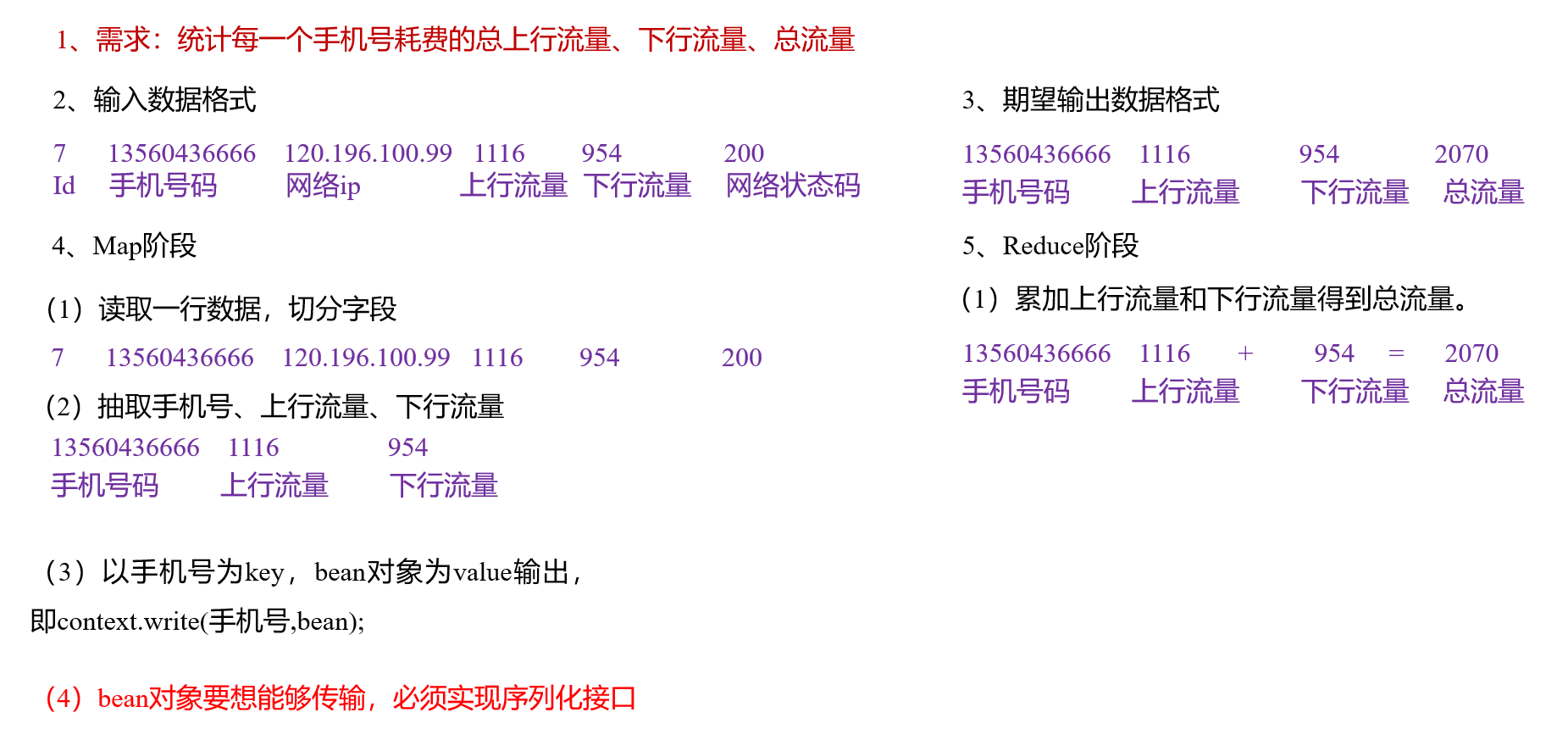
编写 MapReduce 程序
(1)编写流量统计的 Bean 对象
public class FlowBean implements Writable {
/** 上行流量 */
private long upFlow;
/** 下行流量 */
private long downFlow;
/** 总流量 */
private long sumFlow;
public FlowBean() {
}
/**
* 序列化方法 (序列化和反序列化顺序要一致)
*/
@Override
public void write(DataOutput dataOutput) throws IOException {
dataOutput.writeLong(upFlow);
dataOutput.writeLong(downFlow);
dataOutput.writeLong(sumFlow);
}
/**
* 反序列化方法 (序列化和反序列化顺序要一致)
*/
@Override
public void readFields(DataInput dataInput) throws IOException {
this.upFlow = dataInput.readLong();
this.downFlow = dataInput.readLong();
this.sumFlow = dataInput.readLong();
}
/**
* 重写 ToString
*/
@Override
public String toString() {
return upFlow + "\t" + downFlow + "\t" + sumFlow;
}
public long getUpFlow() {
return upFlow;
}
public void setUpFlow(long upFlow) {
this.upFlow = upFlow;
}
public long getDownFlow() {
return downFlow;
}
public void setDownFlow(long downFlow) {
this.downFlow = downFlow;
}
public long getSumFlow() {
return sumFlow;
}
public void setSumFlow(long sumFlow) {
this.sumFlow = sumFlow;
}
}
(2)编写 Mapper 类
public class FlowMapper extends Mapper<LongWritable, Text, Text, FlowBean> {
private Text outK = new Text();
private FlowBean outV = new FlowBean();
@Override
protected void map(LongWritable key, Text value, Context context) throws IOException, InterruptedException {
//1 获取一行数据,转成字符串
String line = value.toString();
//2 切割数据
String[] split = line.split("\t");
//3 抓取我们需要的数据:手机号,上行流量,下行流量
String phone = split[1];
String up = split[split.length - 3];
String down = split[split.length - 2];
//4 封装 outK outV
outK.set(phone);
outV.setUpFlow(Long.parseLong(up));
outV.setDownFlow(Long.parseLong(down));
outV.setSumFlow(Long.parseLong(up) + Long.parseLong(down));
//5 写出 outK outV
context.write(outK, outV);
}
}
(3)编写 Reducer 类
public class FlowReducer extends Reducer<Text, FlowBean, Text, FlowBean> {
private FlowBean outV = new FlowBean();
@Override
protected void reduce(Text key, Iterable<FlowBean> values, Context context) throws IOException,
InterruptedException {
long totalUp = 0;
long totalDown = 0;
//1 遍历 values,将其中的上行流量,下行流量分别累加
for (FlowBean flowBean : values) {
totalUp += flowBean.getUpFlow();
totalDown += flowBean.getDownFlow();
}
//2 封装 outKV
outV.setUpFlow(totalUp);
outV.setDownFlow(totalDown);
outV.setSumFlow(totalUp + totalDown);
//3 写出 outK outV
context.write(key, outV);
}
}
(4)编写 Driver 驱动类
public class FlowDriver {
public static void main(String[] args) throws IOException, ClassNotFoundException, InterruptedException {
//1 获取 job 对象
Configuration conf = new Configuration();
Job job = Job.getInstance(conf);
//2 关联本 Driver 类
job.setJarByClass(FlowDriver.class);
//3 关联 Mapper 和 Reducer
job.setMapperClass(FlowMapper.class);
job.setReducerClass(FlowReducer.class);
//4 设置 Map 端输出 KV 类型
job.setMapOutputKeyClass(Text.class);
job.setMapOutputValueClass(FlowBean.class);
//5 设置程序最终输出的 KV 类型
job.setOutputKeyClass(Text.class);
job.setOutputValueClass(FlowBean.class);
//6 设置程序的输入输出路径
FileInputFormat.setInputPaths(job, new Path("hadoop-example/src/main/resources/phone_data.txt"));
FileOutputFormat.setOutputPath(job, new Path("hadoop-example/src/main/resources/phone_output"));
//7 提交 Job
boolean b = job.waitForCompletion(true);
System.exit(b ? 0 : 1);
}
}
结果:
13470253144 180 180 360
13509468723 7335 110349 117684
13560439638 918 4938 5856
13568436656 3597 25635 29232
13590439668 1116 954 2070
13630577991 6960 690 7650
13682846555 1938 2910 4848
13729199489 240 0 240
13736230513 2481 24681 27162
13768778790 120 120 240
13846544121 264 0 264
13956435636 132 1512 1644
13966251146 240 0 240
13975057813 11058 48243 59301
13992314666 3008 3720 6728
15043685818 3659 3538 7197
15910133277 3156 2936 6092
15959002129 1938 180 2118
18271575951 1527 2106 3633
18390173782 9531 2412 11943
84188413 4116 1432 5548
MapReduce 框架原理
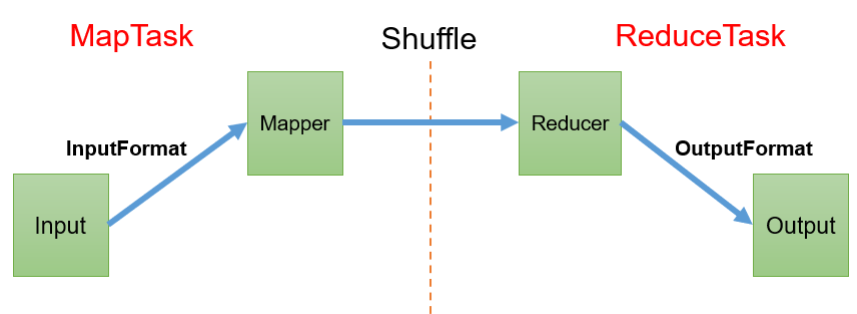
InputFormat 数据输入
切片与 MapTask 并行度决定机制
问题引出
MapTask 的并行度决定 Map 阶段的任务处理并发度,进而影响到整个 Job 的处理速度。
思考:1G 的数据,启动 8 个 MapTask,可以提高集群的并发处理能力。那么 1K 的数据,也启动 8 个 MapTask,会提高集群性能吗?MapTask 并行任务是否越多越好呢?哪些因素影响了 MapTask 并行度?
MapTask 并行度决定机制
数据块:Block 是 HDFS 物理上把数据分成一块一块。数据块是 HDFS 存储数据单位。
数据切片:数据切片只是在逻辑上对输入进行分片,并不会在磁盘上将其切分成片进行存储。数据切片是 MapReduce 程序计算输入数据的单位,一个切片会对应启动一个 MapTask。
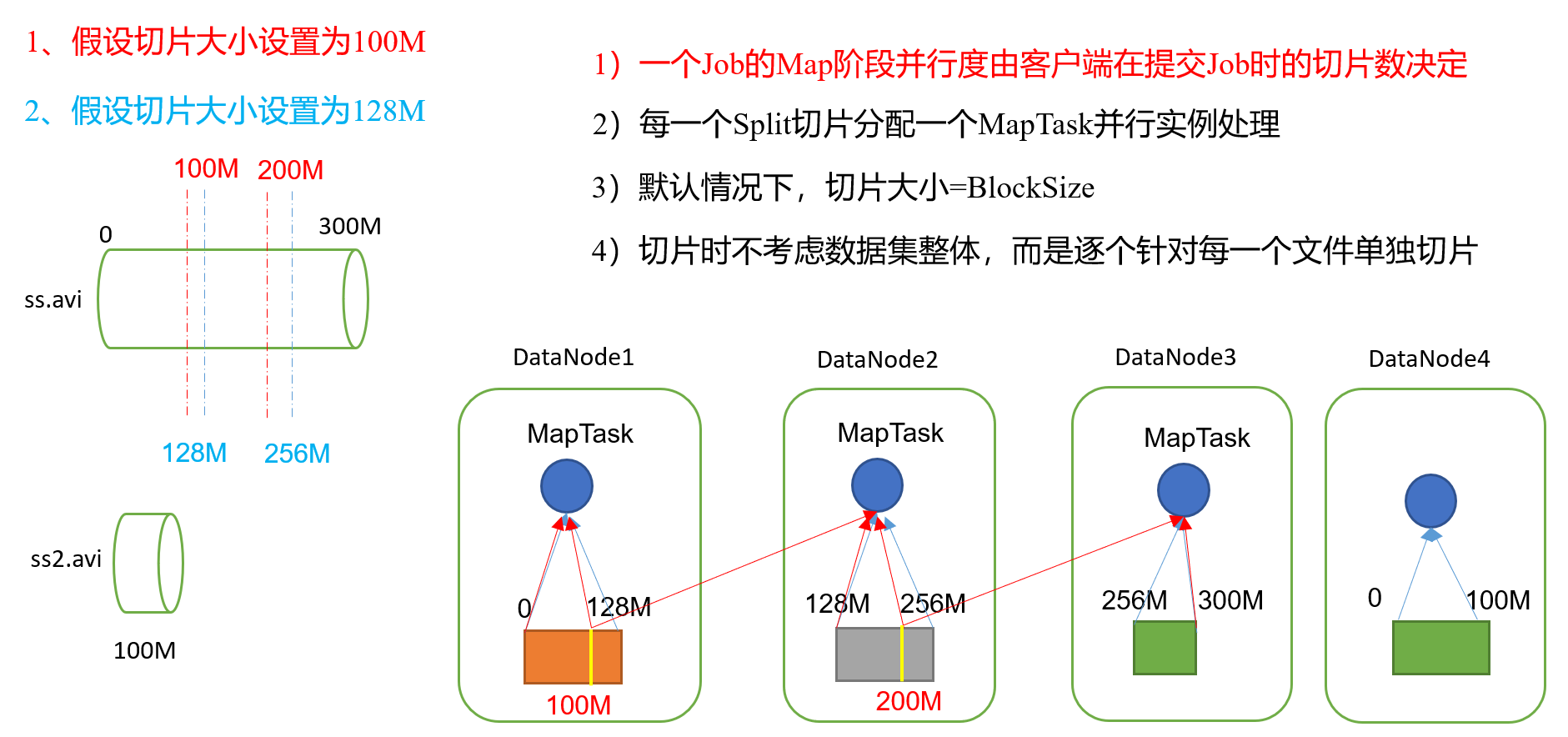
InputFormat实现类
思考:在运行 MapReduce 程序时,输入的文件格式包括:基于行的日志文件、二进制格式文件、数据库表等。那么,针对不同的数据类型,MapReduce 是如何读取这些数据的呢?
FileInputFormat 实现类
FileInputFormat 常见的接口实现类包括:TextInputFormat、KeyValueTextInputFormat、NLineInputFormat、CombineTextInputFormat 和自定义 InputFormat 等。
TextInputFormat
TextInputFormat 是默认的 FileInputFormat 实现类。按行读取每条记录。键是存储该行在整个文件中的起始字节偏移量, LongWritable 类型。值是这行的内容,不包括任何行终止符(换行符和回车符),Text 类型。
以下是一个示例,比如,一个分片包含了如下 4 条文本记录。
Rich learning form
Intelligent learning engine
Learning more convenient
From the real demand for more close to the enterprise
每条记录表示为以下键/值对:
(0,Rich learning form)
(20,Intelligent learning engine)
(49,Learning more convenient)
(74,From the real demand for more close to the enterprise)
CombineTextInputFormat 切片机制
框架默认的 TextInputFormat 切片机制是对任务按文件规划切片,不管文件多小,都会是一个单独的切片,都会交给一个 MapTask,这样如果有大量小文件,就会产生大量的MapTask,处理效率极其低下。
1)应用场景:
CombineTextInputFormat 用于小文件过多的场景,它可以将多个小文件从逻辑上规划到一个切片中,这样,多个小文件就可以交给一个 MapTask 处理。
2)虚拟存储切片最大值设置
CombineTextInputFormat.setMaxInputSplitSize(job, 4194304);// 4m
注意:虚拟存储切片最大值设置最好根据实际的小文件大小情况来设置具体的值。
3)切片机制
生成切片过程包括:虚拟存储过程和切片过程二部分。
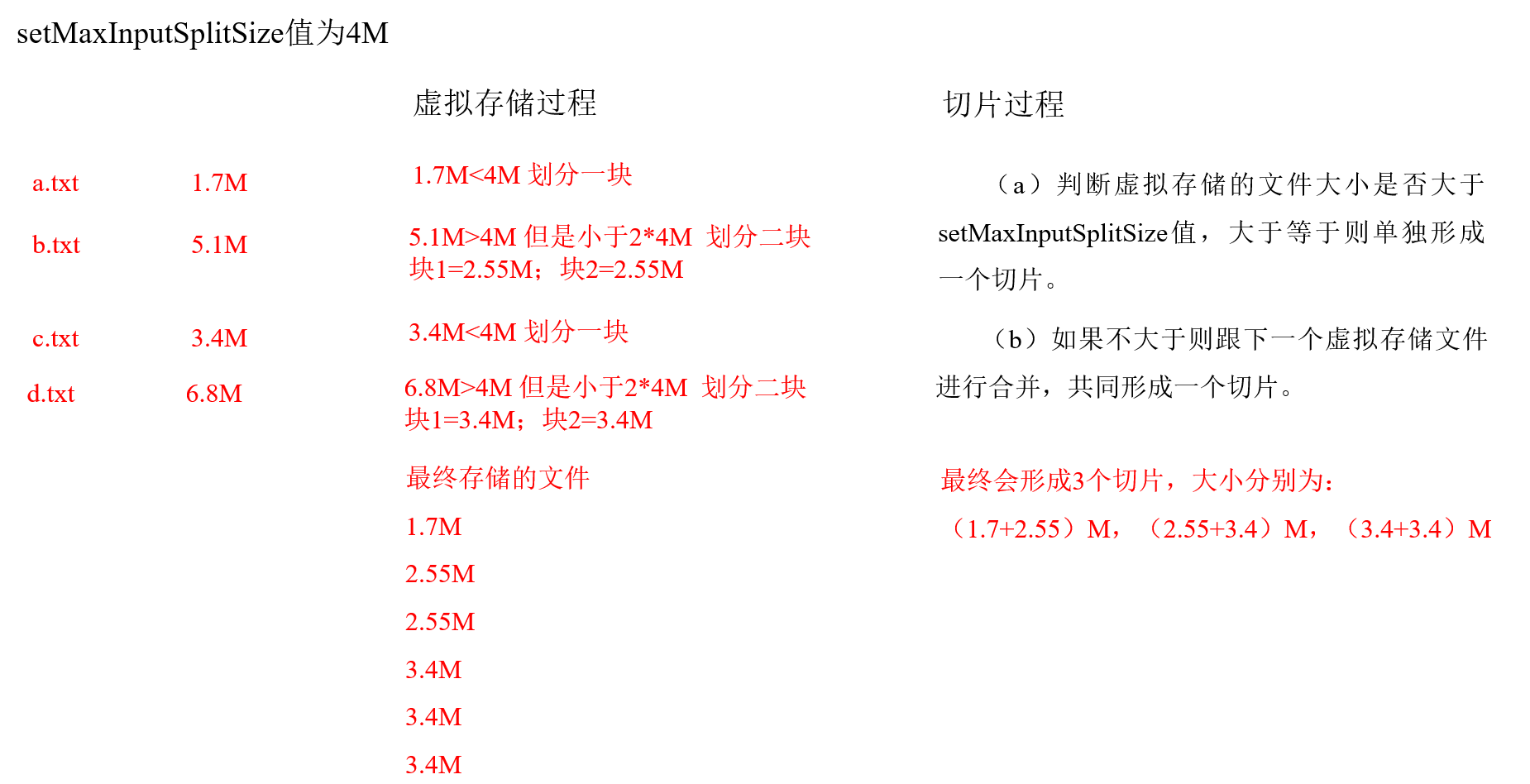
(1)虚拟存储过程:
将输入目录下所有文件大小,依次和设置的 setMaxInputSplitSize 值比较,如果不大于设置的最大值,逻辑上划分一个块。如果输入文件大于设置的最大值且大于两倍,那么以最大值切割一块:当剩余数据大小超过设置的最大值且不大于最大值 2 倍,此时将文件均分成 2 个虚拟存储块(防止出现太小切片)。
例如 setMaxInputSplitSize 值为 4M,输入文件大小为 8.02M,则先逻辑上分成一个4M。剩余的大小为 4.02M,如果按照 4M 逻辑划分,就会出现 0.02M 的小的虚拟存储文件,所以将剩余的 4.02M 文件切分成(2.01M 和 2.01M)两个文件。
(2)切片过程:
(a)判断虚拟存储的文件大小是否大于 setMaxInputSplitSize 值,大于等于则单独形成一个切片。
(b)如果不大于则跟下一个虚拟存储文件进行合并,共同形成一个切片。
(c)测试举例:有 4 个小文件大小分别为 1.7M、5.1M、3.4M 以及 6.8M 这四个小文件,则虚拟存储之后形成 6 个文件块,大小分别为:
1.7M,(2.55M、2.55M),3.4M 以及(3.4M、3.4M)
最终会形成 3 个切片,大小分别为:
(1.7+2.55)M,(2.55+3.4)M,(3.4+3.4)M
操作:
驱动类中添加代码如下:
// 如果不设置 InputFormat,它默认用的是 TextInputFormat.class
job.setInputFormatClass(CombineTextInputFormat.class);
//虚拟存储切片最大值设置 4m
CombineTextInputFormat.setMaxInputSplitSize(job, 4194304);
MapReduce详细工作流程
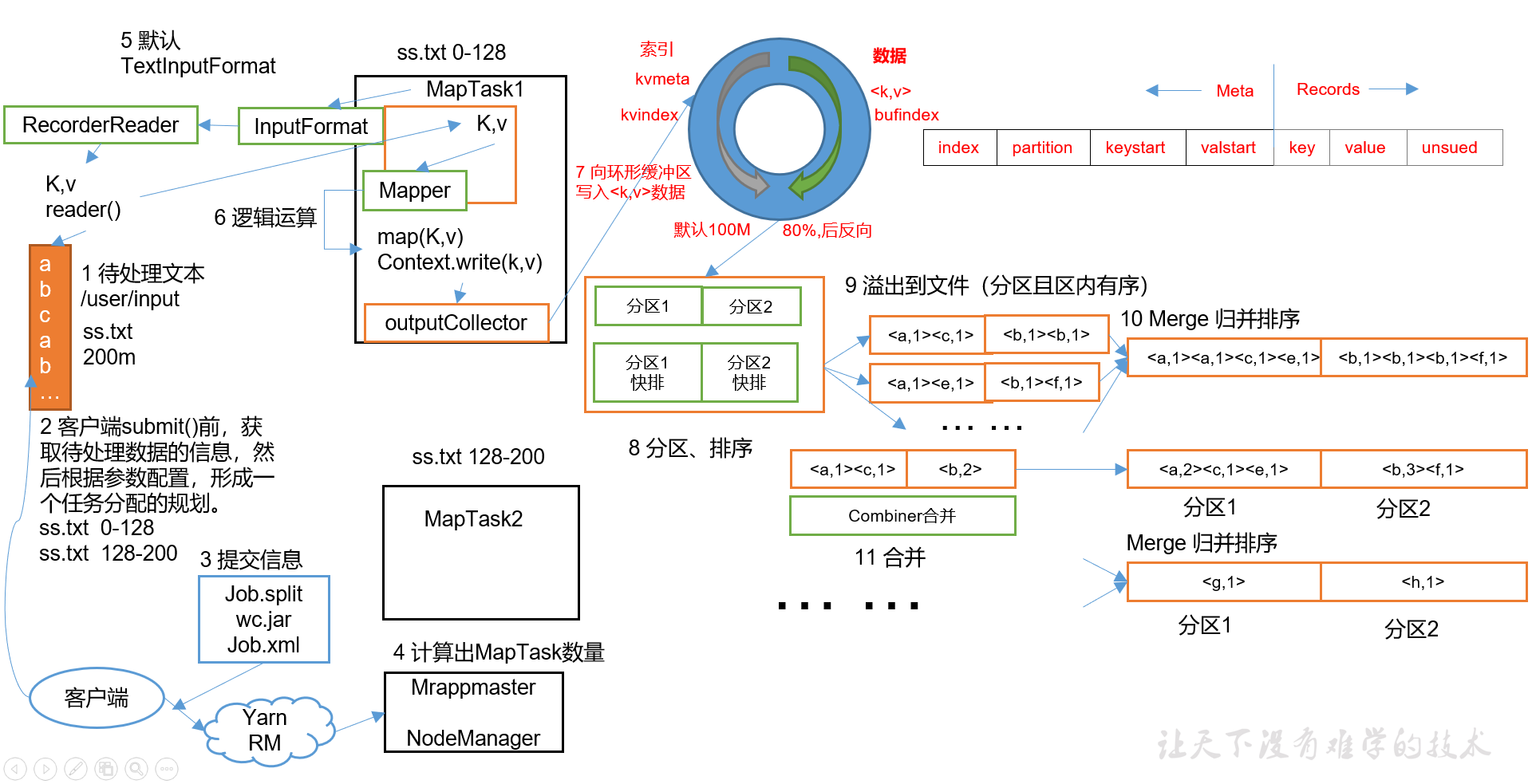
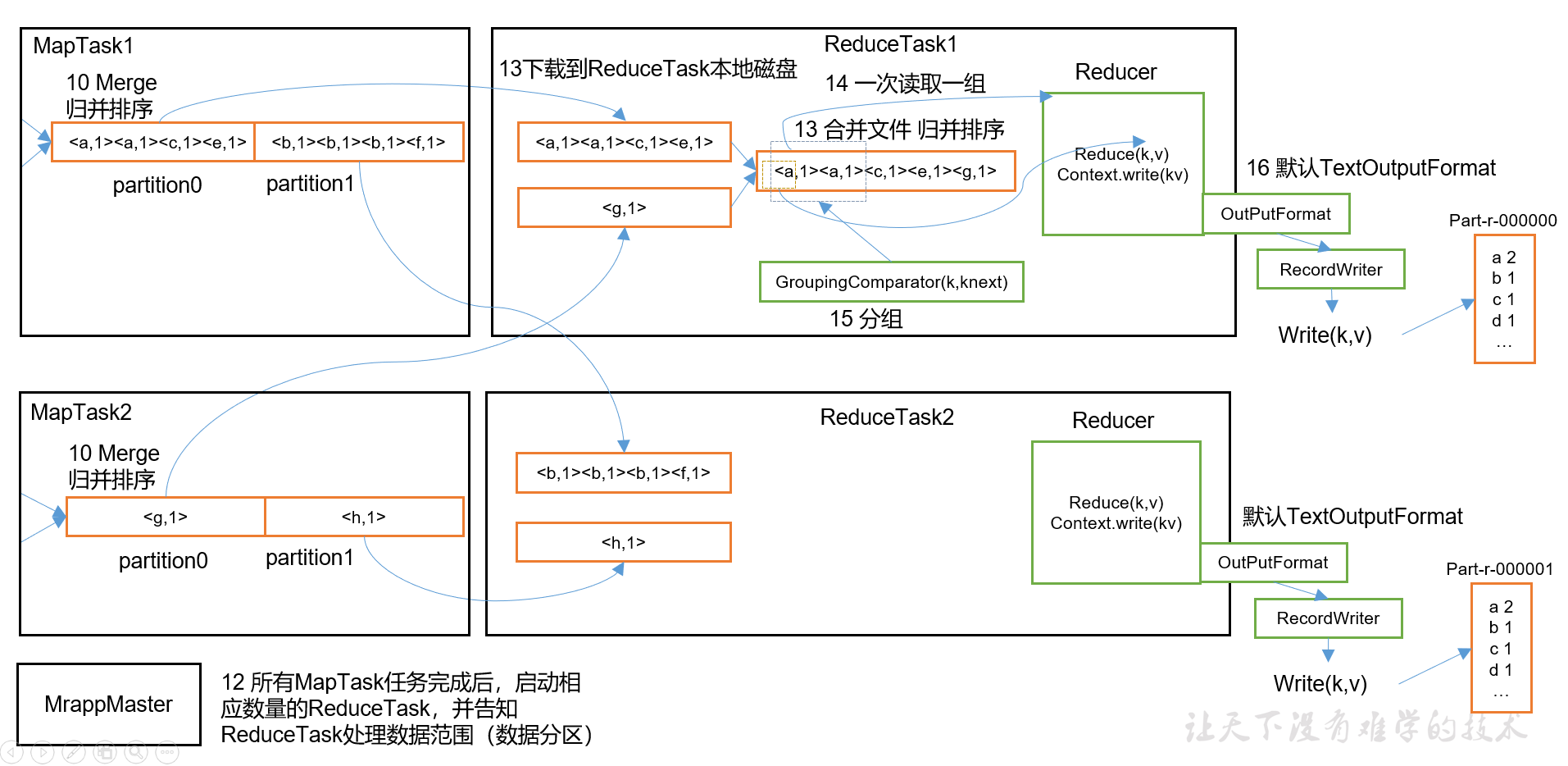
Shuffle 机制
Shuffle 机制
Map 方法之后,Reduce方法之前的数据处理过程称之为 Shuffle。
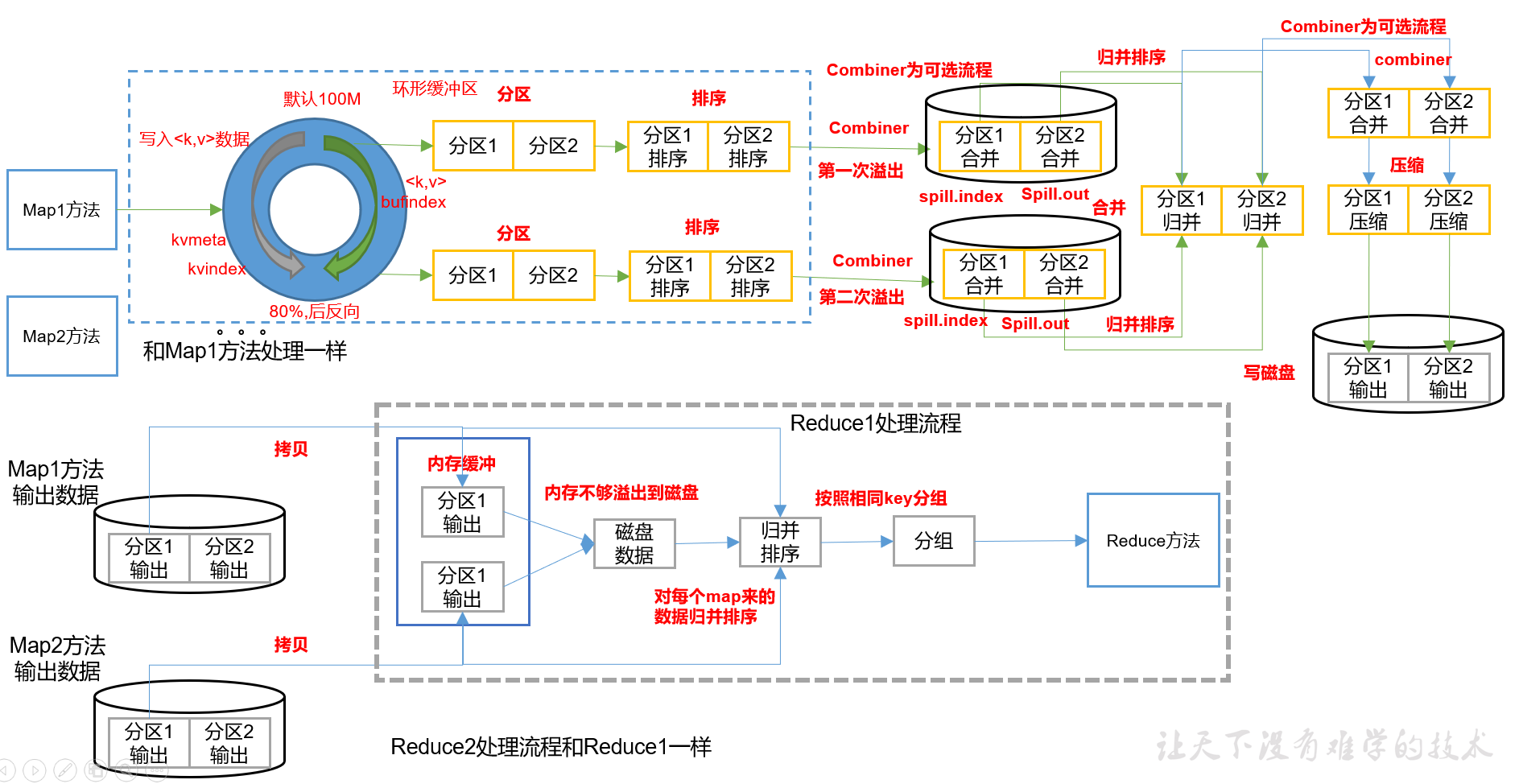
Partition 分区
问题引出
要求将统计结果按照条件输出到不同文件中(分区)。比如:将统计结果按照手机
归属地不同省份输出到不同文件中(分区)
默认Partitioner分区
public class HashPartitioner<K, V> extends Partitioner<K, V>{
public int getPartition(K key, V value, int numReduceTasks) {
return (key.hashCode() & Integer.MAX_VALUE) % numReduceTasks;
}
}
默认分区是根据key的hashCode对ReduceTasks个数取模得到的。用户没法控制哪个key存储到哪个分区。
自定义Partitioner步骤
(1)自定义类继承Partitioner,重写getPartition()方法
public class CustomPartitioner extends Partitioner<Text, FlowBean> {
@Override
public int getPartition(Text key, FlowBean value, int numPartitions) {
// 控制分区代码逻辑
… …
return partition;
}
}
(2)在Job驱动中,设置自定义Partitioner
job.setPartitionerClass(CustomPartitioner.class);
(3)自定义Partition后,要根据自定义Partitioner的逻辑设置相应数量的ReduceTask
job.setNumReduceTasks(5);
分区总结
(1)如果ReduceTask的数量> getPartition的结果数,则会多产生几个空的输出文件part-r-000xx;
(2)如果1<ReduceTask的数量<getPartition的结果数,则有一部分分区数据无处安放,会Exception;
(3)如果ReduceTask的数量=1,则不管MapTask端输出多少个分区文件,最终结果都交给这一个ReduceTask,最终也就只会产生一个结果文件part-r-00000;
案例分析
例如:假设自定义分区数为5,则
(1)job.setNumReduceTasks(1);
(2)job.setNumReduceTasks(2);
(3)job.setNumReduceTasks(6);
会正常运行,只不过会产生一个输出文件会报错大于5,程序会正常运行,会产生空文件
(4)分区号必须从零开始,逐一累加。
Partition 分区实例
需求
将统计结果按照手机归属地不同省份输出到不同文件中(分区)
输入数据:phone_data .txt
期望输出数据 :
手机号 136、137、138、139 开头都分别放到一个独立的 4 个文件中,其他开头的放到一个文件中。
需求分析
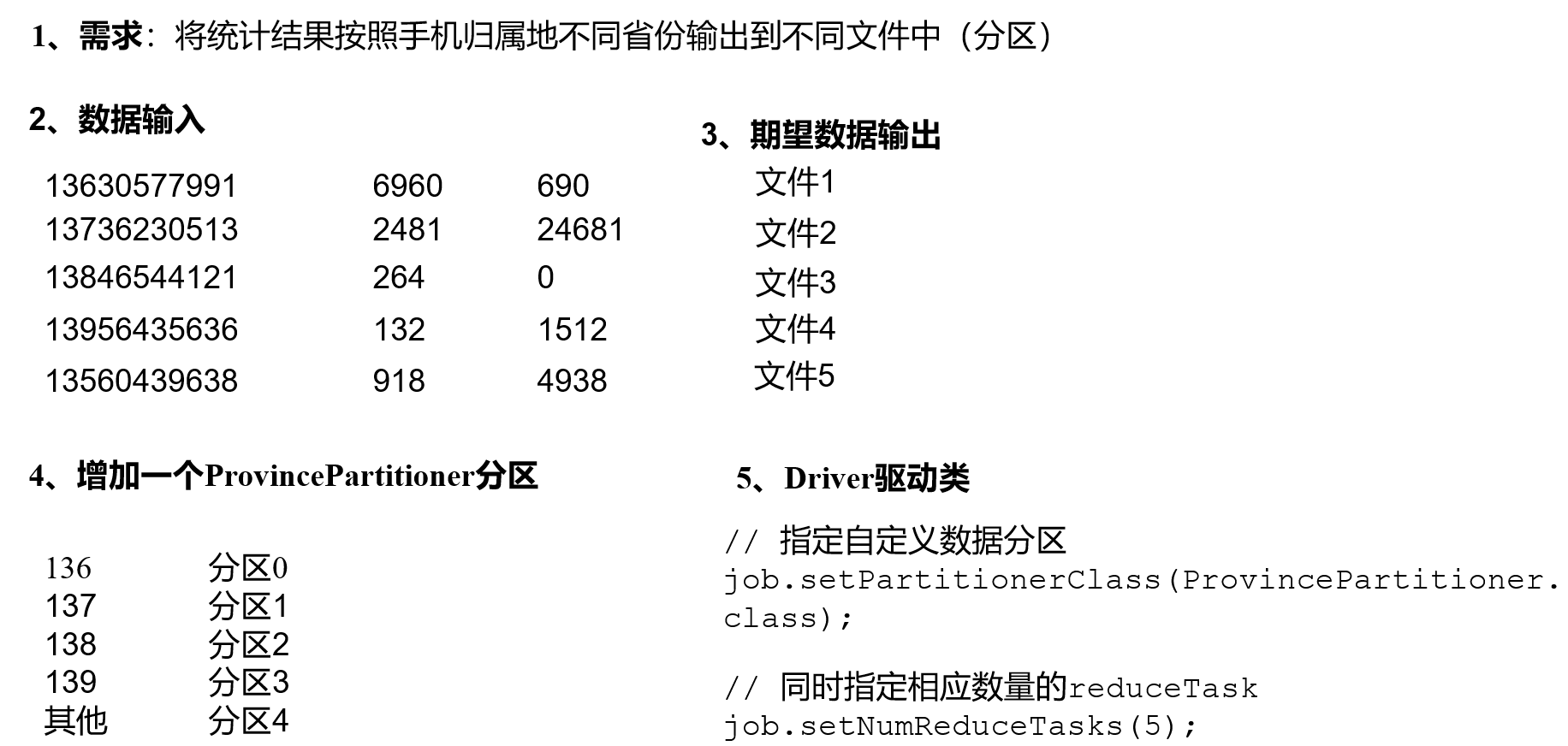
代码实现
在之前的 writable案例(不同手机号的流量统计) 的基础上增加分区操作
增加一个分区类
public class ProvincePartitioner extends Partitioner<Text, FlowBean> {
/**
* 分区逻辑
*/
@Override
public int getPartition(Text text, FlowBean flowBean, int i) {
//获取手机号前三位 prePhone
String phone = text.toString();
String prePhone = phone.substring(0, 3);
//定义一个分区号变量 partition,根据 prePhone 设置分区号
int partition;
switch (prePhone) {
case "136":
partition = 0;
break;
case "137":
partition = 1;
break;
case "138":
partition = 2;
break;
case "139":
partition = 3;
break;
default:
partition = 4;
break;
}
//最后返回分区号 partition
return partition;
}
}
在驱动函数中增加自定义数据分区设置和 ReduceTask 设置
public class FlowPartitionerDriver {
public static void main(String[] args) throws IOException, ClassNotFoundException, InterruptedException {
//1 获取 job 对象
Configuration conf = new Configuration();
Job job = Job.getInstance(conf);
//2 关联本 Driver 类
job.setJarByClass(FlowPartitionerDriver.class);
//3 关联 Mapper 和 Reducer
job.setMapperClass(FlowMapper.class);
job.setReducerClass(FlowReducer.class);
//4 设置 Map 端输出 KV 类型
job.setMapOutputKeyClass(Text.class);
job.setMapOutputValueClass(FlowBean.class);
//5 设置程序最终输出的 KV 类型
job.setOutputKeyClass(Text.class);
job.setOutputValueClass(FlowBean.class);
//8 ** 指定自定义分区器
job.setPartitionerClass(ProvincePartitioner.class);
//9 ** 同时指定相应数量的 ReduceTask
job.setNumReduceTasks(5);
//6 设置程序的输入输出路径
FileInputFormat.setInputPaths(job, new Path("hadoop-example/src/main/resources/phone_data.txt"));
FileOutputFormat.setOutputPath(job, new Path("hadoop-example/src/main/resources/phone_partition_output"));
//7 提交 Job
boolean b = job.waitForCompletion(true);
System.exit(b ? 0 : 1);
}
}
本操作对应步骤8和步骤9。
运行结果
分了5个文件,如下图
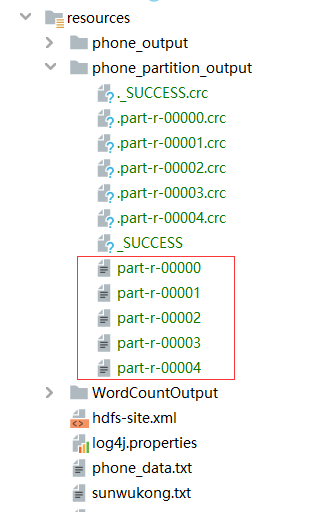
具体文件内容如下:
# part-r-00000
13630577991 6960 690 7650
13682846555 1938 2910 4848
# part-r-00001
13729199489 240 0 240
13736230513 2481 24681 27162
13768778790 120 120 240
# part-r-00002
13846544121 264 0 264
# part-r-00003
13956435636 132 1512 1644
13966251146 240 0 240
13975057813 11058 48243 59301
13992314666 3008 3720 6728
# part-r-00004
13470253144 180 180 360
13509468723 7335 110349 117684
13560439638 918 4938 5856
13568436656 3597 25635 29232
13590439668 1116 954 2070
15043685818 3659 3538 7197
15910133277 3156 2936 6092
15959002129 1938 180 2118
18271575951 1527 2106 3633
18390173782 9531 2412 11943
84188413 4116 1432 5548
从结果看,符合需求。
注意事项
//9 ** 同时指定相应数量的 ReduceTask
job.setNumReduceTasks(5);
- 设置
ReduceTask数量小于分区数时,会报错Illegal partition ……设置 - 设置
ReduceTask数量 = 1 时,结果只会出现一个文件; - 设置
ReduceTask数量大于分区数时,会出现空文件。
WritableComparable 排序
排序概述
排序是MapReduce框架中最重要的操作之一。
MapTask 和ReduceTask 均会对数据按照key 进行排序。该操作属于Hadoop的默认行为。任何应用程序中的数据均会被排序,而不管逻辑上是否需要。
默认排序是按照字典顺序排序,且实现该排序的方法是快速排序。
对于MapTask,它会将处理的结果暂时放到环形缓冲区中,当环形缓冲区使用率达到一定阈值后,再对缓冲区中的数据进行一次快速排序,并将这些有序数据溢写到磁盘上,而当数据处理完毕后,它会对磁盘上所有文件进行归并排序。
对于ReduceTask,它从每个MapTask上远程拷贝相应的数据文件,如果文件大
小超过一定阈值,则溢写磁盘上,否则存储在内存中。如果磁盘上文件数目达到
一定阈值,则进行一次归并排序以生成一个更大文件;如果内存中文件大小或者
数目超过一定阈值,则进行一次合并后将数据溢写到磁盘上。当所有数据拷贝完
毕后,ReduceTask统一对内存和磁盘上的所有数据进行一次归并排序。
排序分类
(1)部分排序
MapReduce根据输入记录的键对数据集排序。保证输出的每个文件内部有序。
(2)全排序
最终输出结果只有一个文件,且文件内部有序。实现方式是只设置一个ReduceTask。但该方法在处理大型文件时效率极低,因为一台机器处理所有文件,完全丧失了MapReduce所提供的并行架构。
(3)辅助排序:(GroupingComparator分组)
在Reduce端对key进行分组。应用于:在接收的key为bean对象时,想让一个或几个字段相同(全部字段比较不相同)的key进入到同一个reduce方法时,可以采用分组排序。
(4)二次排序
在自定义排序过程中,如果compareTo中的判断条件为两个即为二次排序。
自定义排序 WritableComparable 原理分析
bean 对象做为 key 传输,需要实现 WritableComparable 接口重写 compareTo 方法,就可以实现排序。
@Override
public int compareTo(FlowBean bean) {
int result;
// 按照总流量大小,倒序排列
if (this.sumFlow > bean.getSumFlow()) {
result = -1;
}else if (this.sumFlow < bean.getSumFlow()) {
result = 1;
}else {
result = 0;
}
return result;
}
WritableComparable 排序实例(全排序)
需求
在之前的 writable案例(不同手机号的流量统计) 的基础上进行全排序(一个文件,倒序排列)。
期望输出数据:
13509468723 7335 110349 117684
13736230513 2481 24681 27162
13956435636 132 1512 1644
13846544121 264 0 264
……
需求分析
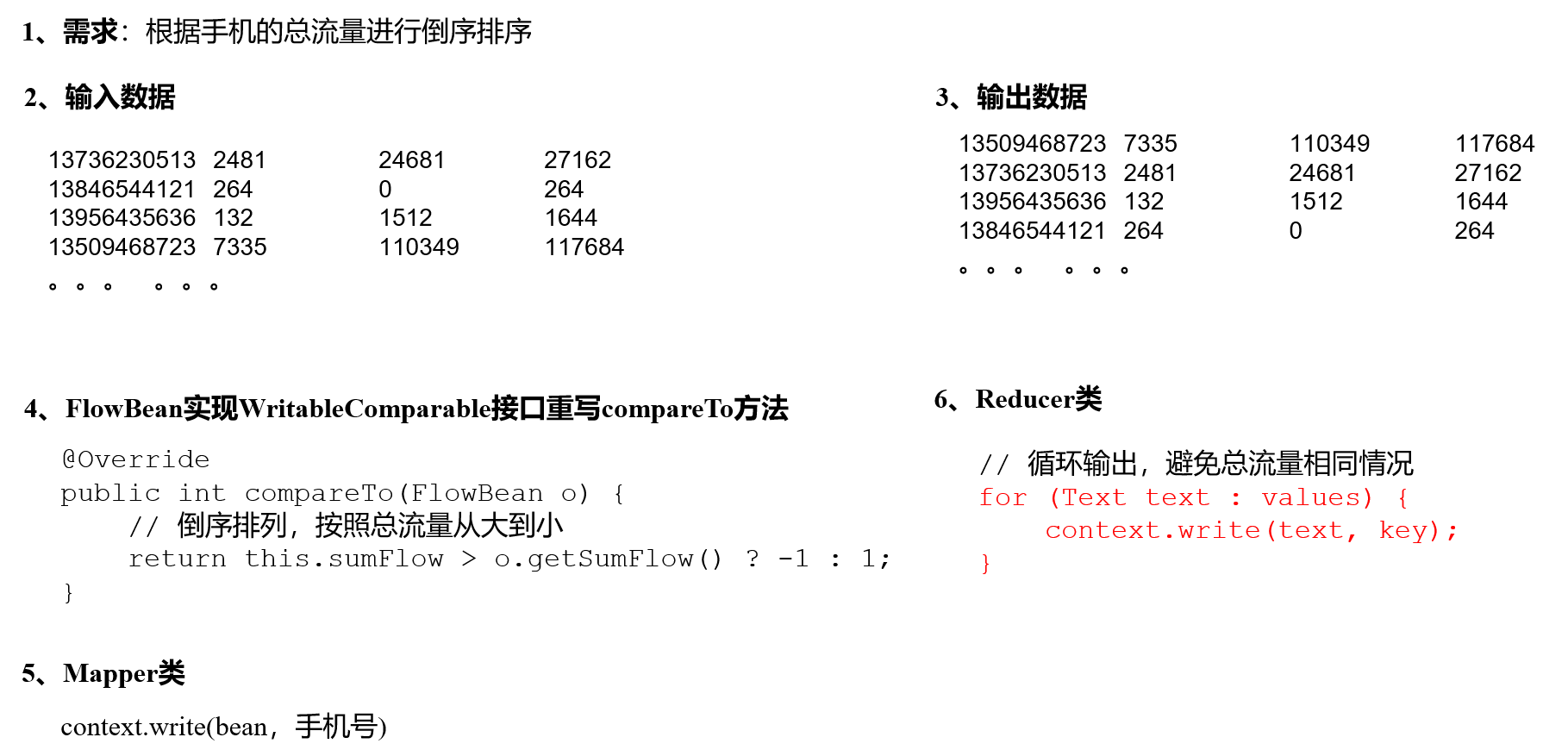
代码实现
(1)FlowBean 对象在增加了比较功能
public class FlowBean implements WritableComparable<FlowBean> {
/** 上行流量 */
private long upFlow;
/** 下行流量 */
private long downFlow;
/** 总流量 */
private long sumFlow;
public FlowBean() {
}
/**
* 序列化方法 (序列化和反序列化顺序要一致)
*/
@Override
public void write(DataOutput dataOutput) throws IOException {
dataOutput.writeLong(upFlow);
dataOutput.writeLong(downFlow);
dataOutput.writeLong(sumFlow);
}
/**
* 反序列化方法 (序列化和反序列化顺序要一致)
*/
@Override
public void readFields(DataInput dataInput) throws IOException {
this.upFlow = dataInput.readLong();
this.downFlow = dataInput.readLong();
this.sumFlow = dataInput.readLong();
}
/**
* 重写 ToString
*/
@Override
public String toString() {
return upFlow + "\t" + downFlow + "\t" + sumFlow;
}
public long getUpFlow() {
return upFlow;
}
public void setUpFlow(long upFlow) {
this.upFlow = upFlow;
}
public long getDownFlow() {
return downFlow;
}
public void setDownFlow(long downFlow) {
this.downFlow = downFlow;
}
public long getSumFlow() {
return sumFlow;
}
public void setSumFlow(long sumFlow) {
this.sumFlow = sumFlow;
}
@Override
public int compareTo(FlowBean o) {
//按照总流量比较,倒序排列
if (this.sumFlow > o.sumFlow) {
return - 1;
} else if (this.sumFlow < o.sumFlow) {
return 1;
} else {
// 按照上行流量的正序排
if (this.upFlow > o.upFlow) {
return - 1;
} else if (this.upFlow < o.upFlow) {
return 1;
} else {
return 0;
}
}
}
}
(2)编写 Mapper 类
Mapper类的输出类型调换了顺序,保证可以在Reduce阶段对FlowBean进行排序处理。
public class FlowMapper extends Mapper<LongWritable, Text, FlowBean, Text> {
private FlowBean outK = new FlowBean();
private Text outV = new Text();
@Override
protected void map(LongWritable key, Text value, Context context) throws IOException, InterruptedException {
//1 获取一行数据,转成字符串
String line = value.toString();
//2 切割数据
String[] split = line.split("\t");
//3 封装 outK outV
outK.setUpFlow(Long.parseLong(split[1]));
outK.setDownFlow(Long.parseLong(split[2]));
outK.setSumFlow(Long.parseLong(split[1]) + Long.parseLong(split[2]));
outV.set(split[0]);
//4 写出 outK outV
context.write(outK, outV);
}
}
(3)编写 Reducer 类
Reducer类的输入类型调换了顺序,保证可以在Reduce阶段可以接收Map阶段的结果。输出时将K和V进行调换,保持原有的输出逻辑。
public class FlowReducer extends Reducer<FlowBean, Text, Text, FlowBean> {
@Override
protected void reduce(FlowBean key, Iterable<Text> values, Context context) throws IOException,
InterruptedException {
//遍历 values 集合,循环写出,避免总流量相同的情况
for (Text value : values) {
//调换 KV 位置,反向写出
context.write(value, key);
}
}
}
(4)编写 Driver 类
Driver 类输入文件为 序列化案例的结果文件。
public class FlowDriver {
public static void main(String[] args) throws IOException, ClassNotFoundException, InterruptedException {
//1 获取 job 对象
Configuration conf = new Configuration();
Job job = Job.getInstance(conf);
//2 关联本 Driver 类
job.setJarByClass(FlowDriver.class);
//3 关联 Mapper 和 Reducer
job.setMapperClass(FlowMapper.class);
job.setReducerClass(FlowReducer.class);
//4 设置 Map 端输出 KV 类型 (更换原有类型)
job.setMapOutputKeyClass(FlowBean.class);
job.setMapOutputValueClass(Text.class);
//5 设置程序最终输出的 KV 类型
job.setOutputKeyClass(Text.class);
job.setOutputValueClass(FlowBean.class);
//6 设置程序的输入输出路径
// writablecomparable_all 目录为之前序列化案例的文件
FileInputFormat.setInputPaths(job, new Path("hadoop-example/src/main/resources/writablecomparable_all_input"));
FileOutputFormat.setOutputPath(job, new Path("hadoop-example/src/main/resources/writablecomparable_all_output"
));
//7 提交 Job
boolean b = job.waitForCompletion(true);
System.exit(b ? 0 : 1);
}
}
结果:
13509468723 7335 110349 117684
13975057813 11058 48243 59301
13568436656 3597 25635 29232
13736230513 2481 24681 27162
18390173782 9531 2412 11943
13630577991 6960 690 7650
15043685818 3659 3538 7197
13992314666 3008 3720 6728
15910133277 3156 2936 6092
13560439638 918 4938 5856
84188413 4116 1432 5548
13682846555 1938 2910 4848
18271575951 1527 2106 3633
15959002129 1938 180 2118
13590439668 1116 954 2070
13956435636 132 1512 1644
13470253144 180 180 360
13846544121 264 0 264
13729199489 240 0 240
13768778790 120 120 240
13966251146 240 0 240
可以看出整体上按照 总流量降序排序 ,但是最后几个总流量相同时,还是按照key的自然升序排序;如果需要在总流量相同时,按照上行流量排序该怎么办?
二次排序
二次排序,只需要更改 FlowBean 的对比方法即可:
@Override
public int compareTo(FlowBean o) {
//按照总流量比较,倒序排列
if (this.sumFlow > o.sumFlow) {
return - 1;
} else if (this.sumFlow < o.sumFlow) {
return 1;
} else {
// 按照上行流量的正序排
if (this.upFlow > o.upFlow) {
return - 1;
} else if (this.upFlow < o.upFlow) {
return 1;
} else {
return 0;
}
}
}
结果:
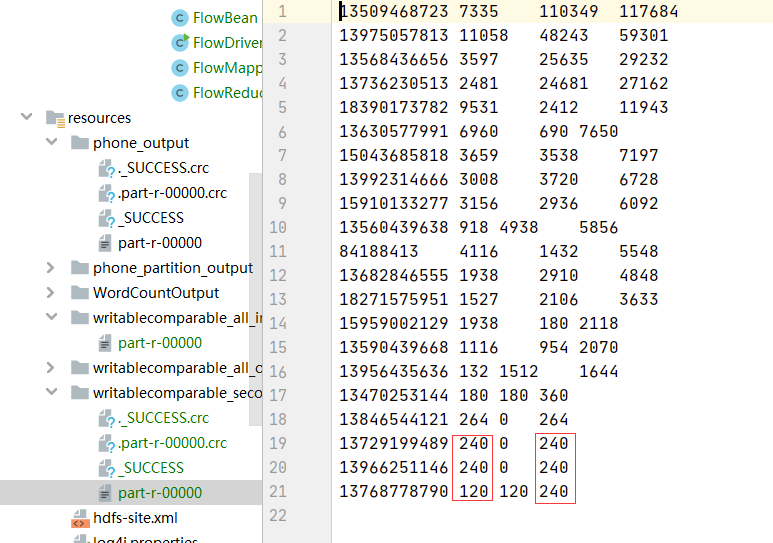
可以看出,当总流量为240时,3行相同的数据,按照上行流量倒序排序。
WritableComparable 排序实例(区内排序)
需求
要求每个省份手机号输出的文件中按照总流量内部排序。
需求分析
基于前一个需求,增加自定义分区类,分区按照省份手机号设置。
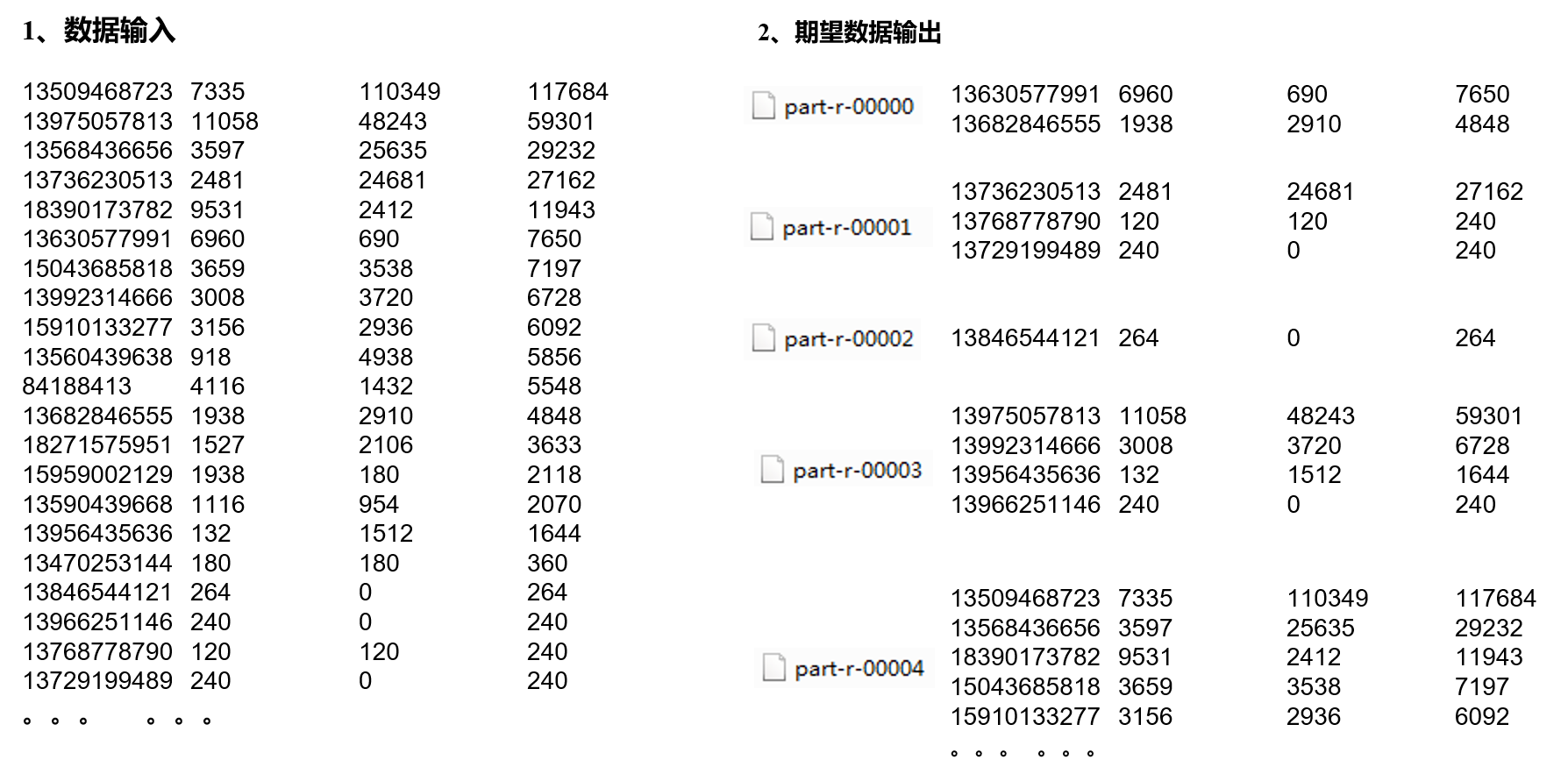
代码实现
(1)增加自定义分区类
在Map阶段之后进行分区,所以K/V泛型与Map阶段输出的类型一致。
public class PartProvincePartitioner extends Partitioner<FlowBean, Text> {
/**
* 分区逻辑
*/
@Override
public int getPartition(FlowBean flowBean, Text text, int i) {
//获取手机号前三位 prePhone
String phone = text.toString();
String prePhone = phone.substring(0, 3);
//定义一个分区号变量 partition,根据 prePhone 设置分区号
int partition;
switch (prePhone) {
case "136":
partition = 0;
break;
case "137":
partition = 1;
break;
case "138":
partition = 2;
break;
case "139":
partition = 3;
break;
default:
partition = 4;
break;
}
//最后返回分区号 partition
return partition;
}
}
(2)在驱动类中添加分区类
//8 ** 指定自定义分区器
job.setPartitionerClass(PartProvincePartitioner.class);
//9 ** 同时指定相应数量的 ReduceTask
job.setNumReduceTasks(5);
结果:
# part-r-00000
13630577991 6960 690 7650
13682846555 1938 2910 4848
# part-r-00001
13736230513 2481 24681 27162
13729199489 240 0 240
13768778790 120 120 240
# part-r-00002
13846544121 264 0 264
# part-r-00003
13975057813 11058 48243 59301
13992314666 3008 3720 6728
13956435636 132 1512 1644
13966251146 240 0 240
# part-r-00004
13509468723 7335 110349 117684
13568436656 3597 25635 29232
18390173782 9531 2412 11943
15043685818 3659 3538 7197
15910133277 3156 2936 6092
13560439638 918 4938 5856
84188413 4116 1432 5548
18271575951 1527 2106 3633
15959002129 1938 180 2118
13590439668 1116 954 2070
13470253144 180 180 360
生成了5个文件,每个文件按照总流量倒序,总流量相同时按照上行流量倒序排序。
Combiner 合并
(1)Combiner是MR程序中Mapper和Reducer之外的一种组件。
(2)Combiner组件的父类就是Reducer。
(3)Combiner和Reducer的区别在于运行的位置
- Combiner是在每一个MapTask所在的节点运行;
- Reducer是接收全局所有Mapper的输出结果;
(4)Combiner的意义就是对每一个MapTask的输出进行局部汇总,以减小网络传输量。
(5)Combiner能够应用的前提是不能影响最终的业务逻辑,而且,Combiner的输出kv应该跟Reducer的输入kv类型要对应起来。
(6)自定义 Combiner 实现步骤 .
- 自定义一个 Combiner 继承 Reducer,重写 Reduce 方法
public class WordCountCombiner extends Reducer<Text,IntWritable, Text, IntWritable> {
private IntWritable outV = new IntWritable();
@Override
protected void reduce(Text key, Iterable<IntWritable> values, Context context) throws IOException,InterruptedException {
int sum = 0;
for (IntWritable value : values) {
sum += value.get();
}
outV.set(sum);
context.write(key,outV);
}
}
- 在 Job 驱动类中设置:
job.setCombinerClass(WordCountCombiner.class);
Combiner 合并实例
需求
统计过程中对每一个 MapTask 的输出进行局部汇总,以减小网络传输量即采用
Combiner 功能。
期望:Combine 输入数据多,输出时经过合并,输出数据降低。
需求分析
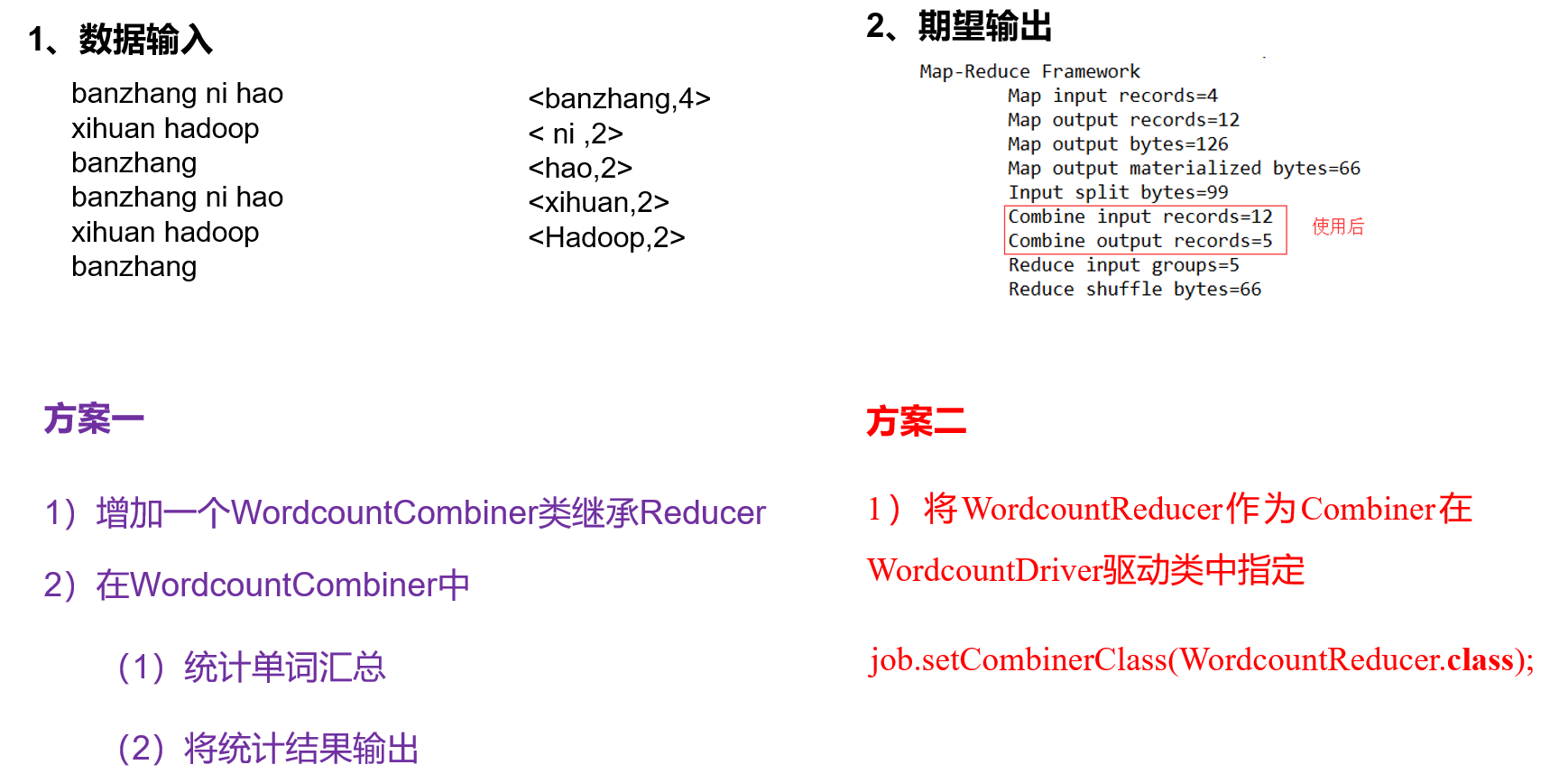
代码实现——方案1
(1)增加一个 WordCountCombiner 类继承 Reducer
public class WordCountCombiner extends Reducer<Text, IntWritable, Text, IntWritable> {
private IntWritable outV = new IntWritable();
@Override
protected void reduce(Text key, Iterable<IntWritable> values, Context
context) throws IOException, InterruptedException {
int sum = 0;
for (IntWritable value : values) {
sum += value.get();
}
//封装 outKV
outV.set(sum);
//写出 outKV
context.write(key, outV);
}
}
(2)在 WordcountDriver 驱动类中指定 Combiner
// 指定需要使用 combiner,以及用哪个类作为 combiner 的逻辑
job.setCombinerClass(WordCountCombiner.class);
代码实现——方案2
(1)将 WordcountReducer 作为 Combiner 在 WordcountDriver 驱动类中指定
// 指定需要使用 Combiner,以及用哪个类作为 Combiner 的逻辑
job.setCombinerClass(WordCountReducer.class);
结果:
[外链图片转存失败,源站可能有防盗链机制,建议将图片保存下来直接上传(img-0ToXUItP-1635411063031)(C:\Users\rsw\AppData\Roaming\Typora\typora-user-images\image-20211008210526769.png)]
OutputFormat 数据输出
OutputFormat 接口实现类
OutputFormat是MapReduce输出的基类,所有实现MapReduce输出都实现了OutputFormat接口。下面我们介绍几种常见的OutputFormat实现类。
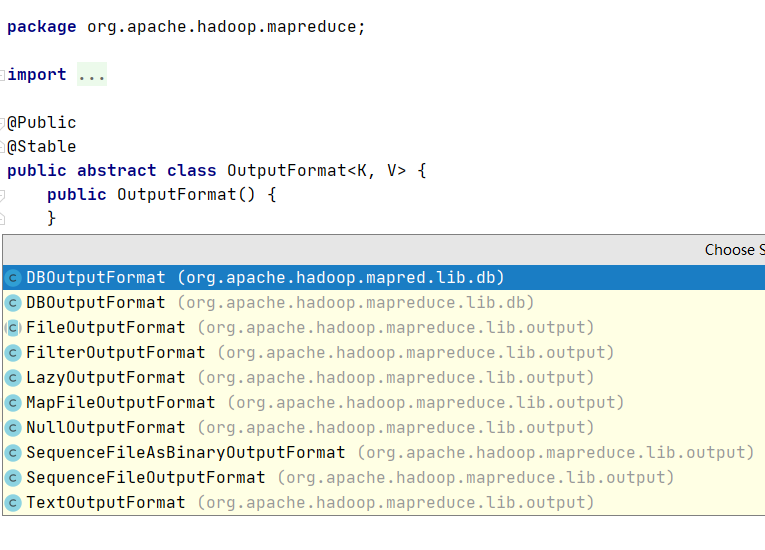
默认输出格式 TextOutputFormat。
也可使用自定义OutputFormat。
应用场景:
例如:输出数据到MySQL/HBase/Elasticsearch等存储框架中。
自定义OutputFormat步骤
- 自定义一个类继承FileOutputFormat。
- 改写RecordWriter,具体改写输出数据的方法write()。
自定义 OutputFormat 实例
需求
过滤输入的 log 日志,包含 duktig 的网站输出到 resources/OutputFormat_output/duktig .log,不包含duktig 的网站输出到 resources/OutputFormat_output/other.log。
代码实现
(1)编写 LogMapper 类
public class LogMapper extends Mapper<LongWritable, Text, Text, NullWritable> {
@Override
protected void map(LongWritable key, Text value, Context context) throws IOException, InterruptedException {
//不做任何处理,直接写出一行 log 数据
context.write(value, NullWritable.get());
}
}
(2)编写 LogReducer 类
public class LogReducer extends Reducer<Text, NullWritable, Text, NullWritable> {
@Override
protected void reduce(Text key, Iterable<NullWritable> values, Context context) throws IOException,
InterruptedException {
// 防止有相同的数据,迭代写出
for (NullWritable value : values) {
context.write(key, NullWritable.get());
}
}
}
(3)自定义一个 LogOutputFormat 类
public class LogOutputFormat extends FileOutputFormat<Text, NullWritable> {
@Override
public RecordWriter<Text, NullWritable> getRecordWriter(TaskAttemptContext taskAttemptContext) throws IOException
, InterruptedException {
//创建一个自定义的 RecordWriter 返回
return new LogRecordWriter(taskAttemptContext);
}
}
(4)编写 LogRecordWriter 类
public class LogRecordWriter extends RecordWriter<Text, NullWritable> {
private FSDataOutputStream duktigOut;
private FSDataOutputStream otherOut;
public LogRecordWriter(TaskAttemptContext job) {
try {
//获取文件系统对象
FileSystem fs = FileSystem.get(job.getConfiguration());
//用文件系统对象创建两个输出流对应不同的目录
duktigOut = fs.create(new Path("hadoop-example/src/main/resources/OutputFormat_output/duktig.log"));
otherOut = fs.create(new Path("hadoop-example/src/main/resources/OutputFormat_output/other.log"));
} catch (IOException e) {
e.printStackTrace();
}
}
@Override
public void write(Text key, NullWritable value) throws IOException, InterruptedException {
String log = key.toString();
//根据一行的 log 数据是否包含 duktig,判断两条输出流输出的内容
if (log.contains("duktig")) {
duktigOut.writeBytes(log + "\n");
} else {
otherOut.writeBytes(log + "\n");
}
}
@Override
public void close(TaskAttemptContext context) throws IOException, InterruptedException {
//关流
IOUtils.closeStream(duktigOut);
IOUtils.closeStream(otherOut);
}
}
(5)编写 LogDriver 类
public class LogDriver {
public static void main(String[] args) throws IOException, ClassNotFoundException, InterruptedException {
Configuration conf = new Configuration();
Job job = Job.getInstance(conf);
job.setJarByClass(LogDriver.class);
job.setMapperClass(LogMapper.class);
job.setReducerClass(LogReducer.class);
job.setMapOutputKeyClass(Text.class);
job.setMapOutputValueClass(NullWritable.class);
job.setOutputKeyClass(Text.class);
job.setOutputValueClass(NullWritable.class);
//设置自定义的 outputformat
job.setOutputFormatClass(LogOutputFormat.class);
FileInputFormat.setInputPaths(job, new Path("hadoop-example/src/main/resources/OutputFormat_input"));
//虽 然 我 们 自 定 义 了 outputformat, 但 是 因 为 我 们 的 outputformat 继 承 自fileoutputformat
//而 fileoutputformat 要输出一个_SUCCESS 文件,所以在这还得指定一个输出目录
FileOutputFormat.setOutputPath(job, new Path("hadoop-example/src/main/resources/OutputFormat_output"));
boolean b = job.waitForCompletion(true);
System.exit(b ? 0 : 1);
}
}
结果
初始文件 OutputFormat_input.txt:
https://github.com/duktig666
https://duktig.cn
http://duktig.cn
http://www.duktig.cn
http://api.duktig.cn
https://www.baidu.com
https://www.zhihu.com
https://www.google.com
结果:
duktig.log
http://api.duktig.cn
http://duktig.cn
http://www.duktig.cn
https://duktig.cn
https://github.com/duktig666
other.log
https://www.baidu.com
https://www.google.com
https://www.zhihu.com
需求实现,而且结果也是根据key进行自然升序排序。
MapReduce深度解析
MapTask 工作机制

(1)Read 阶段:MapTask 通过 InputFormat 获得的 RecordReader,从输入 InputSplit 中解析出一个个 key/value。
(2)Map 阶段:该节点主要是将解析出的 key/value 交给用户编写 map()函数处理,并产生一系列新的 key/value。
(3)Collect 收集阶段:在用户编写 map()函数中,当数据处理完成后,一般会调用OutputCollector.collect()输出结果。在该函数内部,它会将生成的 key/value 分区(调用Partitioner),并写入一个环形内存缓冲区中。
(4)Spill 阶段:即“溢写”,当环形缓冲区满后,MapReduce 会将数据写到本地磁盘上,生成一个临时文件。需要注意的是,将数据写入本地磁盘之前,先要对数据进行一次本地排序,并在必要时对数据进行合并、压缩等操作。
溢写阶段详情:
步骤 1:利用快速排序算法对缓存区内的数据进行排序,排序方式是,先按照分区编号Partition 进行排序,然后按照 key 进行排序。这样,经过排序后,数据以分区为单位聚集在一起,且同一分区内所有数据按照 key 有序。
步骤 2:按照分区编号由小到大依次将每个分区中的数据写入任务工作目录下的临时文件 output/spillN.out(N 表示当前溢写次数)中。如果用户设置了 Combiner,则写入文件之前,对每个分区中的数据进行一次聚集操作。
步骤 3:将分区数据的元信息写到内存索引数据结构 SpillRecord 中,其中每个分区的元信息包括在临时文件中的偏移量、压缩前数据大小和压缩后数据大小。如果当前内存索引大小超过 1MB,则将内存索引写到文件 output/spillN.out.index 中。
(5)Merge 阶段:当所有数据处理完成后,MapTask 对所有临时文件进行一次合并,以确保最终只会生成一个数据文件。 当所有数据处理完后,MapTask 会将所有临时文件合并成一个大文件,并保存到文件output/file.out 中,同时生成相应的索引文件 output/file.out.index。 在进行文件合并过程中,MapTask 以分区为单位进行合并。对于某个分区,它将采用多轮递归合并的方式。每轮合并 mapreduce.task.io.sort.factor(默认10)个文件,并将产生的文件重新加入待合并列表中,对文件排序后,重复以上过程,直到最终得到一个大文件。 让每个 MapTask 最终只生成一个数据文件,可避免同时打开大量文件和同时读取大量小文件产生的随机读取带来的开销。
ReduceTask 工作机制

(1)Copy 阶段:ReduceTask 从各个 MapTask 上远程拷贝一片数据,并针对某一片数据,如果其大小超过一定阈值,则写到磁盘上,否则直接放到内存中。
(2)Sort 阶段:在远程拷贝数据的同时,ReduceTask 启动了两个后台线程对内存和磁盘上的文件进行合并,以防止内存使用过多或磁盘上文件过多。按照 MapReduce 语义,用户编写 reduce()函数输入数据是按 key 进行聚集的一组数据。为了将 key 相同的数据聚在一起,Hadoop 采用了基于排序的策略。由于各个 MapTask 已经实现对自己的处理结果进行了局部排序,因此,ReduceTask 只需对所有数据进行一次归并排序即可。
(3)Reduce 阶段:reduce()函数将计算结果写到 HDFS 上。
ReduceTask 并行度决定机制
回顾:MapTask 并行度由切片个数决定,切片个数由输入文件和切片规则决定。
思考:ReduceTask 并行度由谁决定?
1)设置 ReduceTask 并行度(个数)
ReduceTask 的并行度同样影响整个 Job 的执行并发度和执行效率,但与 MapTask 的并发数由切片数决定不同,ReduceTask 数量的决定是可以直接手动设置:
// 默认值是 1,手动设置为 4
job.setNumReduceTasks(4);
2)实验:测试 ReduceTask 多少合适
(1)实验环境:1 个 Master 节点,16 个 Slave 节点:CPU:8G,内存: 2G
(2)实验结论:

(1)ReduceTask=0,表示没有Reduce阶段,输出文件个数和Map个数一致。
(2)ReduceTask默认值就是1,所以输出文件个数为一个。
(3)如果数据分布不均匀,就有可能在Reduce阶段产生数据倾斜
(4)ReduceTask数量并不是任意设置,还要考虑业务逻辑需求,有些情况下,需要计算全局汇总结果,就只能有1个ReduceTask。
(5)具体多少个ReduceTask,需要根据集群性能而定。
(6)如果分区数不是1,但是ReduceTask为1,是否执行分区过程。答案是:不执行分区过程。因为在MapTask的源码中,执行分区的前提是先判断ReduceNum个数是否大于1。不大于1肯定不执行。
Join 应用
Reduce Join
Map 端的主要工作:为来自不同表或文件的 key/value 对,打标签以区别不同来源的记录。然后用连接字段作为 key,其余部分和新加的标志作为 value,最后进行输出。
Reduce 端的主要工作:在 Reduce 端以连接字段作为 key 的分组已经完成,我们只需要在每一个分组当中将那些来源于不同文件的记录(在 Map 阶段已经打标志)分开,最后进行合并就 ok 了。
Reduce Join 实例
需求
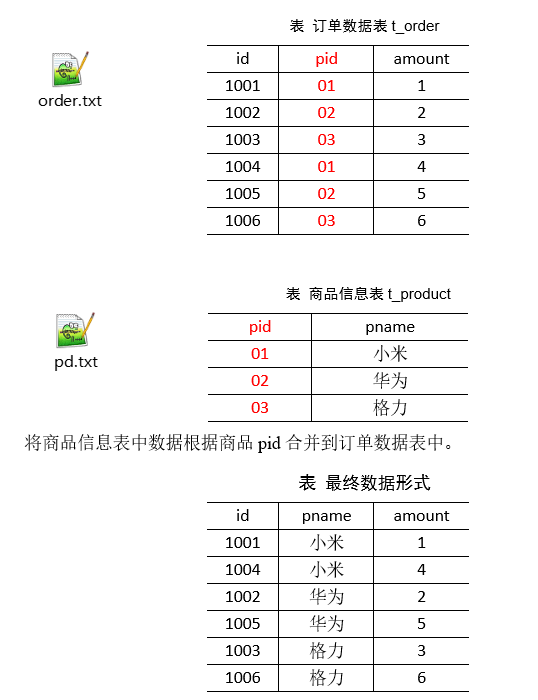
需求分析
通过将关联条件作为 Map 输出的 key,将两表满足 Join 条件的数据并携带数据所来源的文件信息,发往同一个 ReduceTask,在 Reduce 中进行数据的串联。
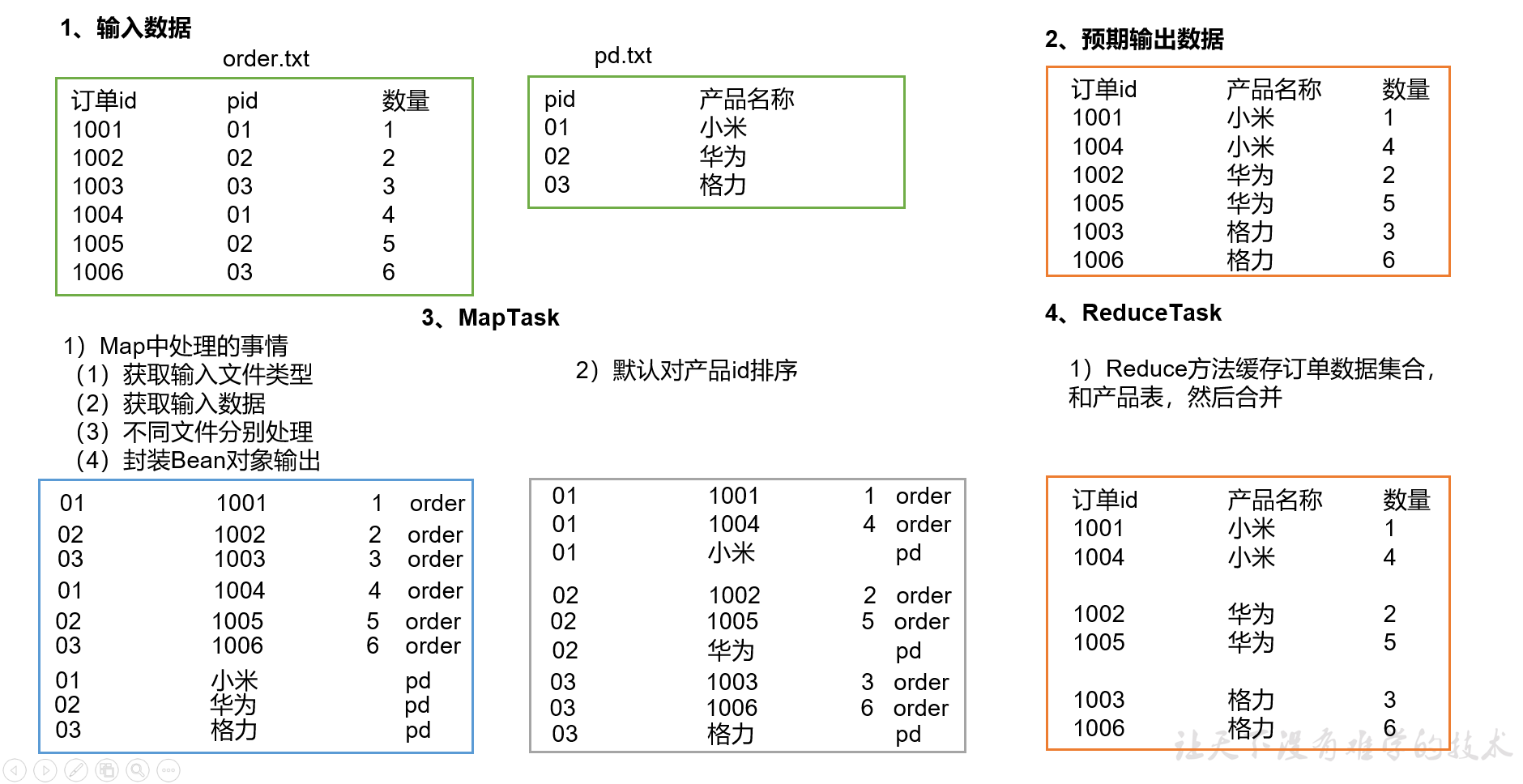
代码实现
(1)创建商品和订单合并后的 TableBean 类
两个文件的共同字段的bean
public class TableBean implements Writable {
/** 订单 id */
private String id;
/** 产品 id */
private String pid;
/** 产品数量 */
private int amount;
/** 产品名称 */
private String name;
/** 判断是 order 表还是 pd表的标志字段 */
private String flag;
public TableBean() {
}
@Override
public void write(DataOutput out) throws IOException {
out.writeUTF(id);
out.writeUTF(pid);
out.writeInt(amount);
out.writeUTF(name);
out.writeUTF(flag);
}
@Override
public void readFields(DataInput in) throws IOException {
this.id = in.readUTF();
this.pid = in.readUTF();
this.amount = in.readInt();
this.name = in.readUTF();
this.flag = in.readUTF();
}
@Override
public String toString() {
return id + "\t" + name + "\t" + amount;
}
public String getId() {
return id;
}
public void setId(String id) {
this.id = id;
}
public String getPid() {
return pid;
}
public void setPid(String pid) {
this.pid = pid;
}
public int getAmount() {
return amount;
}
public void setAmount(int amount) {
this.amount = amount;
}
public String getName() {
return name;
}
public void setName(String name) {
this.name = name;
}
public String getFlag() {
return flag;
}
public void setFlag(String flag) {
this.flag = flag;
}
}
(2)编写 TableMapper 类
/**
* description:join合并实战——map阶段处理 order 和 product 数据
* <p>
* 以连接字段 pid 作为key
*
* <p>
* order文件(map阶段):
* 订单id pid 数量
* 1001 01 1
* 1002 02 2
* ……
* <p>
* product文件(map阶段):
* pid 产品名称
* 01 小米
* 02 华为
* ……
* <p>
* 合并后的文件(reduce阶段):
* 订单id 产品名称 数量
* 1001 小米 1
* 1002 华为 2
* ……
*
* @author RenShiWei
* Date: 2021/10/9 9:30
* blog: https://duktig.cn/
* github知识库: https://github.com/duktig666/knowledge
**/
public class TableMapper extends Mapper<LongWritable, Text, Text, TableBean> {
private String filename;
private Text outK = new Text();
private TableBean outV = new TableBean();
/**
* 初始化
* 如果代码写在 map方法 中,没获取一行都会执行。所以写在这里
*/
@Override
protected void setup(Context context) throws IOException, InterruptedException {
//获取对应文件名称
// 得到切片信息
InputSplit split = context.getInputSplit();
FileSplit fileSplit = (FileSplit) split;
filename = fileSplit.getPath().getName();
}
/**
* 处理order和product文件中的数据
*/
@Override
protected void map(LongWritable key, Text value, Context context) throws IOException, InterruptedException {
//获取一行
String line = value.toString();
//判断是哪个文件,然后针对文件进行不同的操作
//订单表的处理
if (filename.contains("order")) {
String[] split = line.split("\t");
//封装 outK
outK.set(split[1]);
//封装 outV
outV.setId(split[0]);
outV.setPid(split[1]);
outV.setAmount(Integer.parseInt(split[2]));
outV.setName("");
outV.setFlag("order");
} else { //商品表的处理
String[] split = line.split("\t");
//封装 outK
outK.set(split[0]);
//封装 outV
outV.setId("");
outV.setPid(split[0]);
outV.setAmount(0);
outV.setName(split[1]);
outV.setFlag("pd");
}
//写出 KV
context.write(outK, outV);
}
}
(3)编写 TableReducer 类
/**
* description:join实例——reduce阶段,合并 order 和 product 数据
* <p>
* 以连接字段 pid 作为key
*
* <p>
* order文件(map阶段):
* 订单id pid 数量
* 1001 01 1
* 1002 02 2
* ……
* <p>
* product文件(map阶段):
* pid 产品名称
* 01 小米
* 02 华为
* ……
* <p>
* 合并后的文件(reduce阶段):
* 订单id 产品名称 数量
* 1001 小米 1
* 1002 华为 2
* ……
* <p>
* 到达reduce的数据(两个文件的数据都会 以pid为key 到达reduce阶段):
* 1001 01 1
* 1002 02 2
* 01 小米
* 02 华为
* ……
*
* @author RenShiWei
* Date: 2021/10/9 10:31
* blog: https://duktig.cn/
* github知识库: https://github.com/duktig666/knowledge
**/
public class TableReducer extends Reducer<Text, TableBean, TableBean, NullWritable> {
@Override
protected void reduce(Text key, Iterable<TableBean> values, Context context) throws IOException,
InterruptedException {
ArrayList<TableBean> orderBeans = new ArrayList<>();
TableBean pdBean = new TableBean();
// 相同的key,循环遍历value
for (TableBean value : values) {
//判断数据来自哪个表
if ("order".equals(value.getFlag())) { //订单表
//创建一个临时 TableBean 对象接收 value
TableBean tmpOrderBean = new TableBean();
/*
这里不能使用 orderBeans.add(value);
因为 Iterable<TableBean> values 不是Java中的迭代器,是Hadoop提供的,添加的是地址而且会覆盖
造成的结果是:最终只会添加一个对象
也可以考虑使用 高效一点的 BeanUtils.copy
*/
tmpOrderBean.setAmount(value.getAmount());
tmpOrderBean.setFlag(value.getFlag());
tmpOrderBean.setId(value.getId());
//将临时 TableBean 对象添加到集合 orderBeans
orderBeans.add(tmpOrderBean);
} else {
//商品表
pdBean.setName(value.getName());
pdBean.setFlag(value.getFlag());
}
}
//遍历集合 orderBeans,替换掉每个 orderBean 的 pid 为 name,然后写出
for (TableBean orderBean : orderBeans) {
orderBean.setName(pdBean.getName());
//写出修改后的 orderBean 对象
context.write(orderBean, NullWritable.get());
}
}
}
(4)编写 TableDriver 类
public class TableDriver {
public static void main(String[] args) throws IOException, ClassNotFoundException, InterruptedException {
Job job = Job.getInstance(new Configuration());
job.setJarByClass(TableDriver.class);
job.setMapperClass(TableMapper.class);
job.setReducerClass(TableReducer.class);
job.setMapOutputKeyClass(Text.class);
job.setMapOutputValueClass(TableBean.class);
job.setOutputKeyClass(TableBean.class);
job.setOutputValueClass(NullWritable.class);
FileInputFormat.setInputPaths(job, new Path("hadoop-example/src/main/resources/join_reduce_input"));
FileOutputFormat.setOutputPath(job, new Path("hadoop-example/src/main/resources/join_reduce_output"));
boolean b = job.waitForCompletion(true);
System.exit(b ? 0 : 1);
}
}
测试
输入文件
# order.txt
1001 01 1
1002 02 2
1003 03 3
1004 01 4
1005 02 5
1006 03 6
# pd.txt
01 小米
02 华为
03 格力
结果:
1004 小米 4
1001 小米 1
1005 华为 5
1002 华为 2
1006 格力 6
1003 格力 3
总结
缺点:这种方式中,合并的操作是在 Reduce 阶段完成,Reduce 端的处理压力太大,Map节点的运算负载则很低,资源利用率不高,且在 Reduce 阶段极易产生数据倾斜。
解决方案:Map 端实现数据合并。
Map Join
使用场景
Map Join 适用于一张表十分小、一张表很大的场景。
优点
思考:在 Reduce 端处理过多的表,非常容易产生数据倾斜。怎么办?
在 Map 端缓存多张表,提前处理业务逻辑,这样增加 Map 端业务,减少 Reduce 端数据的压力,尽可能的减少数据倾斜。
具体办法:采用 DistributedCache
(1)在 Mapper 的 setup 阶段,将文件读取到缓存集合中。
(2)在 Driver 驱动类中加载缓存。
//缓存普通文件到 Task 运行节点(这里用本地文件模拟分布式缓存)
job.addCacheFile(new URI("file:///e:/cache/pd.txt"));
//如果是集群运行,需要设置 HDFS 路径
job.addCacheFile(new URI("hdfs://hadoop102:8020/cache/pd.txt"));
Map Join 实例
需求同Reduce Join 实例一致
需求分析
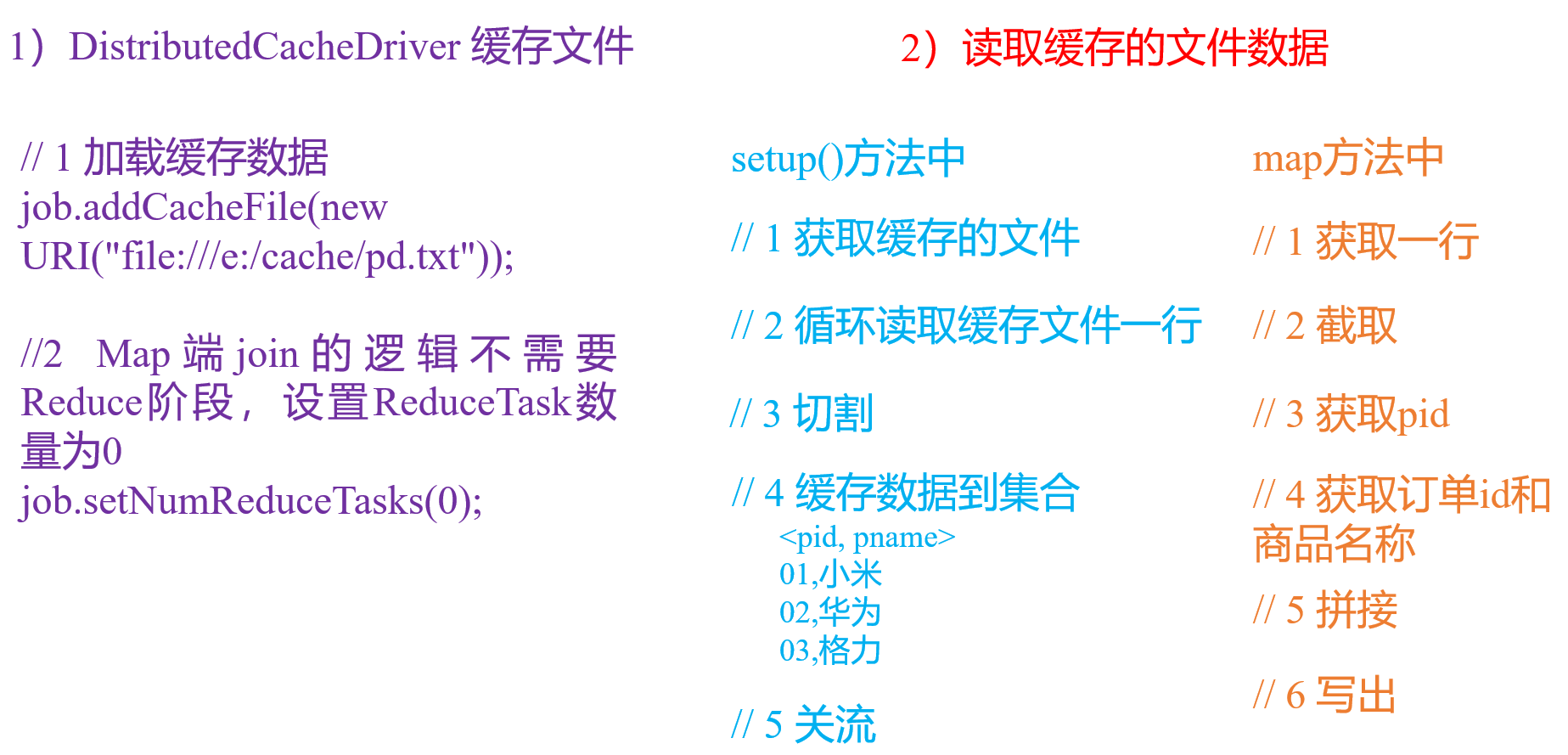
代码实现
(1)先在 MapJoinDriver 驱动类中添加缓存文件
public class MapJoinMapper extends Mapper<LongWritable, Text, Text, NullWritable> {
private Map<String, String> pdMap = new HashMap<>();
private Text outK = new Text();
/**
* 初始化——任务开始前将 pd 数据缓存进 pdMap
* 如果代码写在 map方法 中,没获取一行都会执行。所以写在这里
*/
@Override
protected void setup(Context context) throws IOException,
InterruptedException {
//通过缓存文件得到小表数据 pd.txt
URI[] cacheFiles = context.getCacheFiles();
Path path = new Path(cacheFiles[0]);
//获取文件系统对象,并打开流
FileSystem fs = FileSystem.get(context.getConfiguration());
FSDataInputStream fis = fs.open(path);
//通过包装流转换为 reader,方便按行读取
BufferedReader reader = new BufferedReader(new InputStreamReader(fis, StandardCharsets.UTF_8));
//逐行读取,按行处理
String line;
while (StringUtils.isNotEmpty(line = reader.readLine())) {
//切割一行: 01 小米
String[] split = line.split("\t");
pdMap.put(split[0], split[1]);
}
//关流
IOUtils.closeStream(reader);
}
@Override
protected void map(LongWritable key, Text value, Context context)
throws IOException, InterruptedException {
//读取大表数据: 1001 01 1
String[] fields = value.toString().split("\t");
//通过大表每行数据的 pid,去 pdMap 里面取出 pname
String name = pdMap.get(fields[1]);
//将大表每行数据的 pid 替换为 name
outK.set(fields[0] + "\t" + name + "\t" + fields[2]);
//写出
context.write(outK, NullWritable.get());
}
}
(2)在 MapJoinMapper 类中的 setup 方法中读取缓存文件
public class MapJoinDriver {
public static void main(String[] args) throws IOException, ClassNotFoundException, InterruptedException,
URISyntaxException {
// 1 获取 job 信息
Configuration conf = new Configuration();
Job job = Job.getInstance(conf);
// 2 设置加载 jar 包路径
job.setJarByClass(MapJoinDriver.class);
// 3 关联 mapper
job.setMapperClass(MapJoinMapper.class);
// 4 设置 Map 输出 KV 类型
job.setMapOutputKeyClass(Text.class);
job.setMapOutputValueClass(NullWritable.class);
// 5 设置最终输出 KV 类型
job.setOutputKeyClass(Text.class);
job.setOutputValueClass(NullWritable.class);
// ** 加载缓存数据
job.addCacheFile(new URI("hadoop-example/src/main/resources/join_map/cache/pd.txt"));
// ** Map 端 Join 的逻辑不需要 Reduce 阶段,设置 reduceTask 数量为 0
job.setNumReduceTasks(0);
// 6 设置输入输出路径
FileInputFormat.setInputPaths(job, new Path("hadoop-example/src/main/resources/join_map/input"));
FileOutputFormat.setOutputPath(job, new Path("hadoop-example/src/main/resources/join_map/output"));
// 7 提交
boolean b = job.waitForCompletion(true);
System.exit(b ? 0 : 1);
}
}
测试
结果:
1001 小米 1
1002 华为 2
1003 格力 3
1004 小米 4
1005 华为 5
1006 格力 6
没有reduce阶段,小文件从缓存读取与大文件直接在Map阶段处理,提高效率。
数据清洗(ETL)
“ETL,是英文 Extract-Transform-Load 的缩写,用来描述将数据从来源端经过抽取(Extract)、转换(Transform)、加载(Load)至目的端的过程。ETL 一词较常用在数据仓库,但其对象并不限于数据仓库 。
在运行核心业务 MapReduce 程序之前,往往要先对数据进行清洗,清理掉不符合用户要求的数据。清理的过程往往只需要运行 Mapper 程序,不需要运行 Reduce 程序。
MapReduce 总结
1、输入数据接口:InputFormat
- 默认的实现类是
TextInputformat一次读一行文本, key:该行的起始偏移量,value :一行内容 - 处理小文件
CombineTextInputFormat把多个小文件合并成一个切片处理,提高处理效率。
2、逻辑处理接口:Mapper
setup()初始化;map()用户的业务逻辑;clearup()关闭资源;
3、分区:Partitioner
- 默认分区
HashPartitioner,默认按照 key的hash值 和 numReduces返回分区号:key.hashCode()&Integer.MAXVALUE % numReduces - 如果业务上有特别的需求,可以自定义分区
4、排序:WritableComparable
当我们用自定义的对象作为 key 来输出时,就必须要实现 WritableComparable接口,重写其中的 compareTo()方法。
- 部分排序 :每个输出的文件内部有序。
- 全排序: 对所有数据进行排序,通常只有一个 Reduce。
- 自定义排序 :实现 writableCompare接口, 重写compareTo方法
5、合并 :Combiner
Combiner 合并可以提高程序执行效率,减少 IO 传输。
- 前提:不影响最终的业务逻辑(求和 没问题 求平均值)
- 提前聚合map => 解决数据倾斜的一个方法
6、逻辑处理接口:Reducer
setup()初始化;reduce()用户的业务逻辑;clearup()关闭资源;
7、输出数据接口:OutputFormat
- 默认实现类是 TextOutputFormat,功能逻辑是:将每一个 KV 对,向目标文本文件输出一行。
- 自定义
MapReduce数据压缩
压缩概述
压缩的优缺点
- 压缩的优点:以减少磁盘 IO、减少磁盘存储空间。
- 压缩的缺点:增加 CPU 开销。
压缩原则
- 运算密集型的 Job,少用压缩
- IO 密集型的 Job,多用压缩
MapReduce支持的压缩编码
压缩算法对比介绍
| 压缩格式 | Hadoop自带? | 算法 | 文件扩展名 | 是否可切片 | 换成压缩格式后,原来的程序是否需要修改 |
|---|---|---|---|---|---|
| DEFLATE | 是,直接使用 | DEFLATE | .deflate | 否 | 和文本处理一样,不需要修改 |
| Gzip | 是,直接使用 | DEFLATE | .gz | 否 | 和文本处理一样,不需要修改 |
| bzip2 | 是,直接使用 | bzip2 | .bz2 | 是 | 和文本处理一样,不需要修改 |
| LZO | 否,需要安装 | LZO | .lzo | 是 | 需要建索引,还需要指定输入格式 |
| Snappy | 是,直接使用 | Snappy | .snappy | 否 | 和文本处理一样,不需要修改 |
压缩性能的比较
| 压缩算法 | 原始文件大小 | 压缩文件大小 | 压缩速度 | 解压速度 |
|---|---|---|---|---|
| gzip | 8.3GB | 1.8GB | 17.5MB/s | 58MB/s |
| bzip2 | 8.3GB | 1.1GB | 2.4MB/s | 9.5MB/s |
| LZO | 8.3GB | 2.9GB | 49.3MB/s | 74.6MB/s |
Snappy is a compression/decompression library. It does not aim for maximum compression, or compatibility with any other compression library; instead, it aims for very high speeds and reasonable compression. For instance, compared to the fastest mode of zlib, Snappy is an order of magnitude faster for most inputs, but the resulting compressed files are anywhere from 20% to 100% bigger.On a single core of a Core i7 processor in 64-bit mode, Snappy compresses at about 250 MB/sec or more and decompresses at about 500 MB/sec or more.
http://google.github.io/snappy/
snappy的压缩和解压缩的效率极高
压缩方式选择
压缩方式选择时重点考虑:压缩/解压缩速度、压缩率(压缩后存储大小)、压缩后是否可以支持切片。
Gzip 压缩
优点:压缩率比较高;
缺点:不支持 Split;压缩/解压速度一般;
Bzip2 压缩
优点:压缩率高;支持 Split;
缺点:压缩/解压速度慢。
Lzo 压缩
优点:压缩/解压速度比较快;支持 Split;
缺点:压缩率一般;想支持切片需要额外创建索引。
Snappy 压缩
优点:压缩和解压缩速度快;
缺点:不支持 Split;压缩率一般;
压缩位置选择
压缩可以在 MapReduce 以下三个阶段进行:
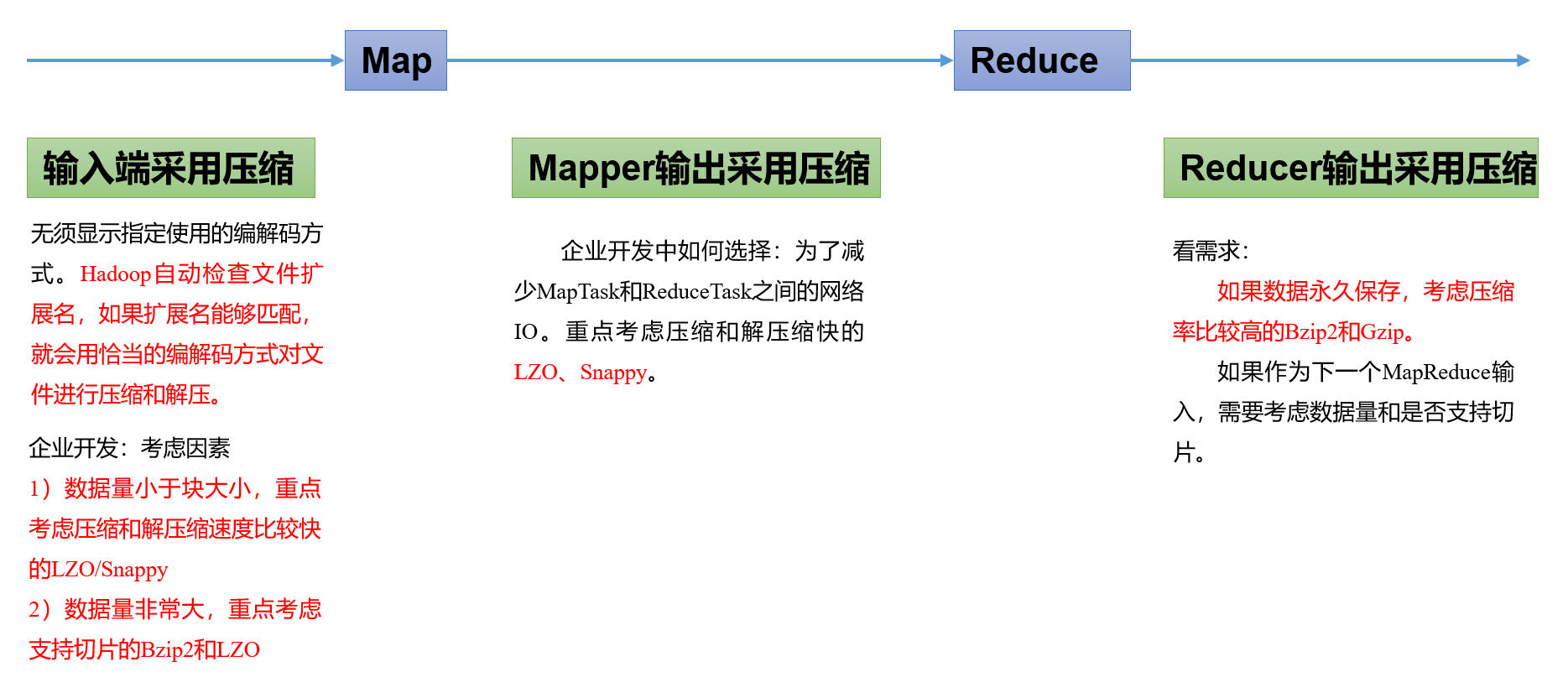
压缩参数配置
为了支持多种压缩/解压缩算法,Hadoop引入了编码/解码器
| 压缩格式 | 对应的编码/解码器 |
|---|---|
| DEFLATE | org.apache.hadoop.io.compress.DefaultCodec |
| gzip | org.apache.hadoop.io.compress.GzipCodec |
| bzip2 | org.apache.hadoop.io.compress.BZip2Codec |
| LZO | com.hadoop.compression.lzo.LzopCodec |
| Snappy | org.apache.hadoop.io.compress.SnappyCodec |
2)要在Hadoop中启用压缩,可以配置如下参数
| 参数 | 默认值 | 阶段 | 建议 |
|---|---|---|---|
| io.compression.codecs (在core-site.xml中配置) | 无,这个需要在命令行输入hadoop checknative查看 | 输入压缩 | Hadoop使用文件扩展名判断是否支持某种编解码器 |
| mapreduce.map.output.compress(在mapred-site.xml中配置) | false | mapper输出 | 这个参数设为true启用压缩 |
| mapreduce.map.output.compress.codec(在mapred-site.xml中配置) | org.apache.hadoop.io.compress.DefaultCodec | mapper输出 | 企业多使用LZO或Snappy编解码器在此阶段压缩数据 |
| mapreduce.output.fileoutputformat.compress(在mapred-site.xml中配置) | false | reducer输出 | 这个参数设为true启用压缩 |
| mapreduce.output.fileoutputformat.compress.codec(在mapred-site.xml中配置) | org.apache.hadoop.io.compress.DefaultCodec | reducer输出 | 使用标准工具或者编解码器,如gzip和bzip2 |
压缩的使用
Map 输出端采用压缩
即使你的 MapReduce 的输入输出文件都是未压缩的文件,你仍然可以对 Map 任务的中间结果输出做压缩,因为它要写在硬盘并且通过网络传输到 Reduce 节点,对其压缩可以提高很多性能,这些工作只要设置两个属性即可。
在Driver 中配置,代码如下:
Configuration conf = new Configuration();
// 开启 map 端输出压缩
conf.setBoolean("mapreduce.map.output.compress", true);
// 设置 map 端输出压缩方式
conf.setClass("mapreduce.map.output.compress.codec",
BZip2Codec.class,CompressionCodec.class);
Mapper和Reducer不变
因为只在Map输出端压缩,在Reduce输入端会自动解压缩,Reduce输出端未压缩,所以最终结果并不存在压缩文件。
Reduce 输出端采用压缩
在Driver 中配置,代码如下:
// 设置 reduce 端输出压缩开启
FileOutputFormat.setCompressOutput(job, true);
// 设置压缩的方式
FileOutputFormat.setOutputCompressorClass(job,BZip2Codec.class);
Mapper 和 Reducer 保持不变。
最终Reduce使用什么压缩方式,会产生对应的压缩格式文件。
MapReduce 常见错误及解决方案
1、Mapper 中第一个输入的参数必须是 LongWritable 或者 NullWritable,不可以是 IntWritable。报的错误是类型转换异常。
2、java.lang.Exception: java.io.IOException: Illegal partition for 13926435656 (4)
说明 Partition和 ReduceTask 个数没对上,调整 ReduceTask 个数。
3、如果分区数不是 1,但是 reducetask 为 1,是否执行分区过程。答案是:不执行分区过程。因为在 MapTask 的源码中,执行分区的前提是先判断 ReduceNum 个数是否大于 1。不大于1 肯定不执行。
4、报类型转换异常。 通常都是在驱动函数中设置 Map 输出和最终输出时编写错误。 Map 输出的 key 如果没有排序,也会报类型转换异常。
5、自定义 Outputformat 时,注意在 RecordWirter 中的 close 方法必须关闭流资源。否则输出的文件内容中数据为空。
@Override
public void close(TaskAttemptContext context) throws IOException,
InterruptedException {
if (atguigufos != null) {
atguigufos.close();
}
if (otherfos != null) {
otherfos.close();
}
}























 1011
1011











 被折叠的 条评论
为什么被折叠?
被折叠的 条评论
为什么被折叠?








